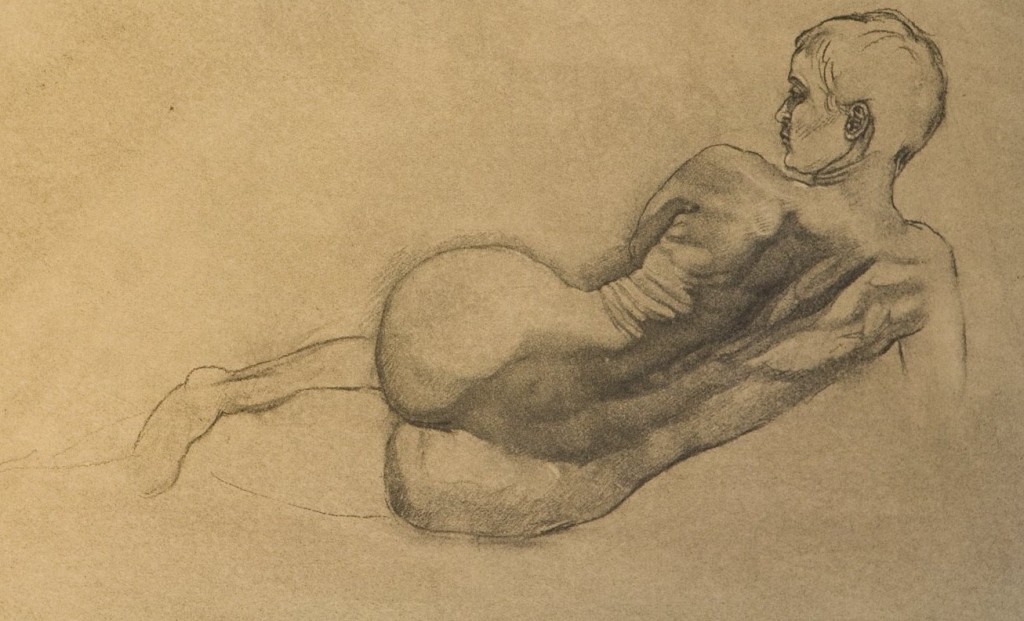Gotha, Friedrich W. E. Döll, sculptor, Vielsdorf, Thuringia 1750–1816, Part Two
Gotha, Friedrich W. E. Döll, sculptor, Vielsdorf, Thuringia 1750–1816 Gotha, Weimar, Jena, Classicism in 18th. and 19th. Century Sculpture
On the History of the Appraisal and Use of Plaster Casts of Ancient Sculpture (especially in Germany and in Berlin), By Adolf H. Borbein, English translation by Bernard Frischer
http://www.digitalsculpture.org/casts/borbein/index.html
In 1665 Lorenzo Bernini, who was already very famous, came to Paris in order to make a portrait of the king. On this occasion, he visited the royal academy of art, looked with little enthusiasm at the works of the members of the academy that were displayed there, and recommended to his assembled colleagues that the education of their students would be better served if the academy created a collection of casts of famous ancient statues, busts, and reliefs. Through drawing the classical models students would come to understand Beauty, and this would be useful for the rest of their life as a standard of quality. It would only hurt young people if they were confronted from the start with Nature. Nature is almost always / [p. 31] feeble and ugly. If the artist only followed Nature, then he would never be able to create something truly beautiful and great.[17]
What Bernini meant is illustrated by a picture made in 1827 by the Danish painter Wilhelm Bendz (fig. 3). A sculptor works after a living model but at the same time he corrects his model by looking at casts of ancient statues, especially the famous “Borghese ‘Gladiator’” in the Louvre, represented in his studio by a cast in reduced format.[18]
Figure 3. Wilhelm Bendz, “A sculptor works after a living model in his studio” (1827). Copenhagen, Statens Museum for Kunst (from: Kunstmuseets Arsskrift 1977–1980, 42 fig. 3).
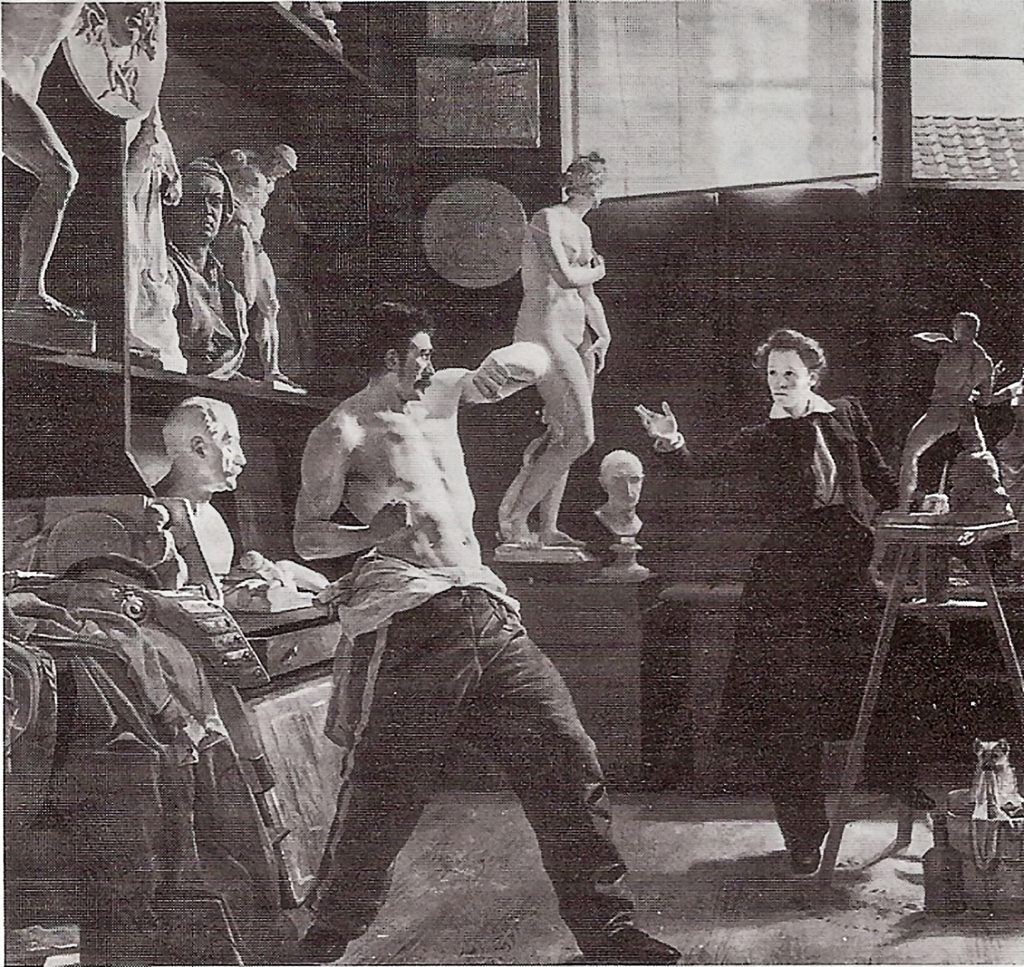
Figure 3 – Wilhelm Bendz, A sculptor works after a living model in his studio
Bernini’s words could have been uttered by Johann Joachim Winckelmann—an oddity, because for Winckelmann Bernini embodied the decline of art, a decline which could only be reversed by reviving understanding of Greek art. Winckelmann’s Geschichte der Kunst des Altertums appeared in 1764 and is primarily a history of sculpture. The descriptions which Winckelmann devoted to the Belvedere Apollo and Torso, sound rhetorical to our ears. Nevertheless, in terms of methodology they were a milestone in the history of sculpture. They showed something still valid today, viz. that the interpretation of a statue presumes the precise description of the object; that it must concentrate on the details without ever losing a sense of the whole and its impact on the observer.[19]
The French sculptor Étienne Falconet (1716-1791), a contemporary of Winckelmann, was convinced that a cast allows the aesthetic qualities of a statue to be more clearly recognized than does the original itself. White plaster, seen under even light, makes it easier to judge pure form. And it makes the strengths and weaknesses of the artist stand out more clearly.[20] Winckelmann designated white as the most beautiful color. According to him, a white, nude body was not only beautiful but also appeared bigger than one that was painted. In this context Wickelmann expressly mentions freshly created plaster casts, which appeared to have a greater volume than their originals.[21] In another passage, Winckelmann combines the cast with Beauty: “The true feeling of the Beautiful approximates a fluid plaster which is poured over the head of Apollo and touches and embraces all its parts.”[22] People liked to view white casts illuminated by torchlight, which made them appear animated. Nighttime visits to cast collections were popular throughout the eighteenth century.[23]
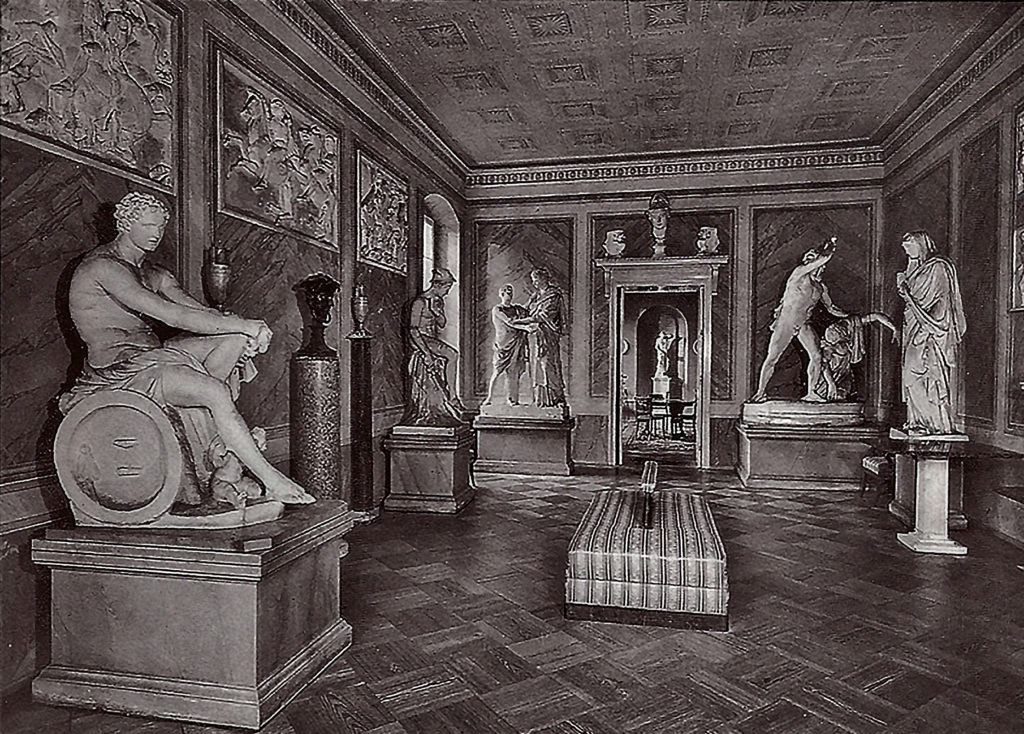
Figure 5 -Berlin Schloß Tegel Antikensaal
The above text on Bernini, Winckelmann, and Falconet taken from:
On the History of the Appraisal and Use of Plaster Casts of Ancient Sculpture (especially in Germany and in Berlin), By Adolf H. Borbein, English translation by Bernard Frischer
http://www.digitalsculpture.org/casts/borbein/index.html
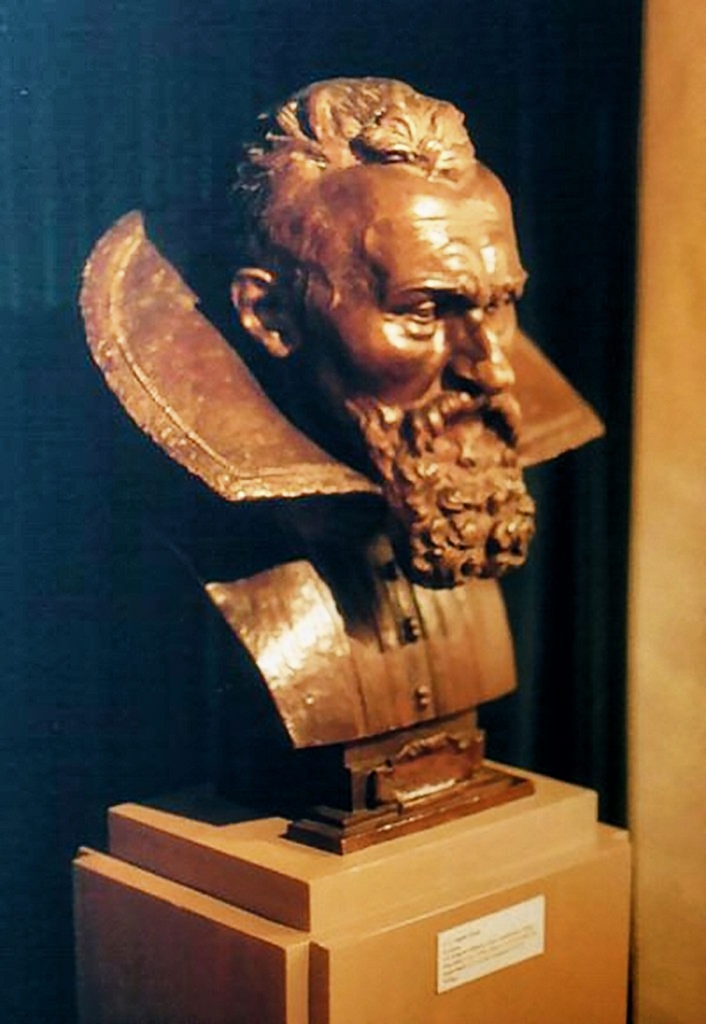
Johannes Kepler Büste von Friedrich Wilhelm Eugen Döll, Hist. Museum, Regensberg Fürst-Anselm-Allee. Denkmal für Johannes Kepler, dorischer Monopteros
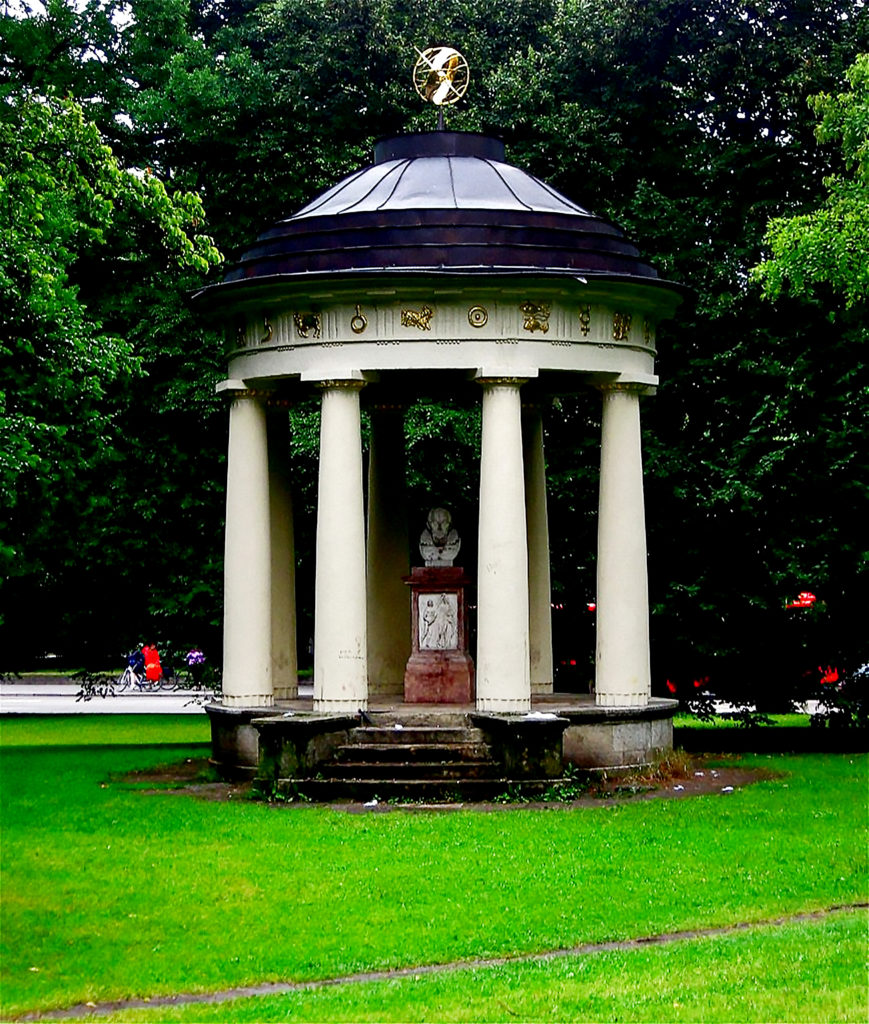


Johannes Kepler Büste von Friedrich Döll, Hist. Museum, Regensberg. Fürst-Anselm-Allee. Monument to Johannes Kepler, with Doric Monopteros
Conical roof, bust, marble relief (copies, originals in the museum Hist.) Astronomical symbols, 1806/1808 by Emanuel d’Herigoyen, sculpture bust of Johannes Kepler, by Frederich Wilhelm Eugen Doell, marble relief added later, sculpted by Johann Heinrich von Dannecker, 1859.

In 1780 Goethe was an apprentice in the Weimar Masonic Anna Amalia zu den drei Rosen aufgenommen (which had to close soon). In April 1782 he finally got the Duke of nobility by the emperor, so that at official occasions he no longer had to sit on the sidelines. In 1783, the recording was followed in the Illuminati as “Abaris”. Besides innumerable odd jobs (masquerades, elevators, redoubts, singing games and occasional poems, mostly for performances in the pleasure palaces of the ducal court) he wrote essentially only “Iphigenia in Tauris”, a play in prose and counterpoint to his life. Government business, the peculiar relationship with Charlotte, simultaneously a half affair with the attractive Corona Schröter – that life was neither noble nor silent. Corona Elisabeth Wilhelmine Schröter also composed songs, setting texts by Frederich Schiller and Johann Wolfgang von Goethe to music. The figures in the Iphigenia, however (even the barbarian prince) are human and calm. Brought to the great beginnings of Frankfurt (“Egmont“, “Faust“, “Der ewige Jude”), he dared not move. But he started the 1778 Bildungsroman “Wilhelm Meister”, just a quiet chamber piece for five people, “Torquato Tasso”. After its success in the youth Goethe could now do with his work no more sensation. There were two unauthorized “total expenditure” (aka piracy), but otherwise, it had depreciated audience and publishers.
http://www.goethezeitportal.de/index.php?id=425
Jutta Assel
Goethe-motives on postcards:Goethe-sculptures
as of June 2015
Klauer 1790 b
See point 10.
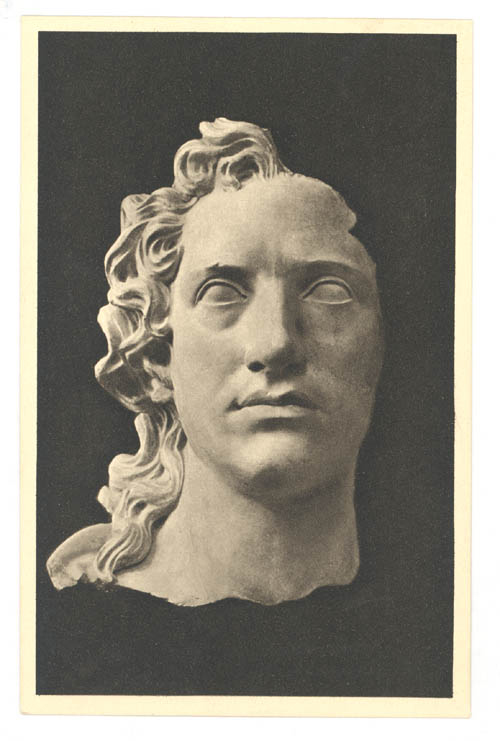
Other pages to Goethe images on postcards
- Contemporary Goethe-portraits and their adaptations http://www.goethezeitportal.de/index.php?id=433
- Stielers Goethe-portrait and its adaptations http://www.goethezeitportal.de /index.php?id=435
- Tischbein “Goethe in the Campagna http://www.goethezeitportal.de/index.php?id=434
- Goethe silhouettes
http://www.goethezeitportal.de/index.php? id = 2556
For picture postcards see: Contemporary Goethe-portraits and their adaptations , Chap 1, with further reading.
- Introduction
“Goethe appreciates the portrayal as a necessary and in a certain sense useful art. In the succession of Lessing, he distinguishes the individual art genres according to their inherent laws, from which the artist’s limited possibilities to choose material and to design.” (G. Körner: On the Difficulties of Portrait Art, p. 154) On the sculpture he sums up (cf. ibid.):
The sculpture art is rightly held so high, because it can and must bring the representation to its highest summit, because it expels man from all that is not essential to him …
“The colourlessness of sculpture, the distribution of light and shadows by its own form, further pushes it from reality to symbolism as the coloring of the painting is able to do, but as far as portrait is concerned, the sculptor can only do it – and the antique busts Offer ideals here, but do not elevate them to the ideal. […] From his intentions to promote art in Germany, from pragmatic considerations, Goethe sees himself and other clients in the duty of sculpture through portrait assignments (Ed., P. 154). The Academy, Goethe demanded, “to make important hunts, especially by traveling, to hunt them, to model them, and to put an imprint in a burnt tone” (cf ibid., P 155)
Goethe himself, like painters who “hunted” for him, afforded very different time for their work or refused meetings, if the artist did not like him. Some artists could Goethe in larger intervals win for meetings, other varied her portrait of Goethe (eg JP Melchior, of his relief portrait of Goethe of 1775 [no. 1 , 2 ] a modified replica 1785 [no. 5 ] produced) or changed the (As from about 1778/79 JP Melchior used the colorless, matte, marble-like bisquite instead of the porcelain).
Variations of the poet bust also show up at MG Klauer (Nos. 4 , 9 , 10 ) by using different materials such as limestone or gypsum (busts of 1779/80 et seq.) Or the new Goethe-bust type of approximately 1790 in blackened plaster Or in sound shaping. Later moldings for commercial exploitation existing in the workshop forms were common and are often carried out less carefully (eg by Klauer son Louis, the next his father also Schadows Goethe bust [no. 14 continues ausformte] in plaster and artificial brick).
For the production of postcards, this means that the reproduced (relief) portrait brushes depict different models – from the artist’s original work to workshop-produced replicas in various materials and different shaping qualities. This explains deviations and prevents precise information about the picture template, if it is not noted on the postcard.
Informative and attractive are the different views as well as illuminations of the busts. Any selected photographers-views can be eg the life mask Weisser (no. 11 – 12 ) look very different. Near-sighted placed in the small format of the postcard, the busts can achieve monumental effect.
Ref : Gudrun grains: About the difficulties of portraiture. Goethe’s relationship to portraits. In: Goethe and Art. Hg. By Sabine Schulze. Ostfildern: Publisher Gerd Hatje 1994, S. 150-158.
1.1 Contemporary Goethe sculptures
Melchior 1775
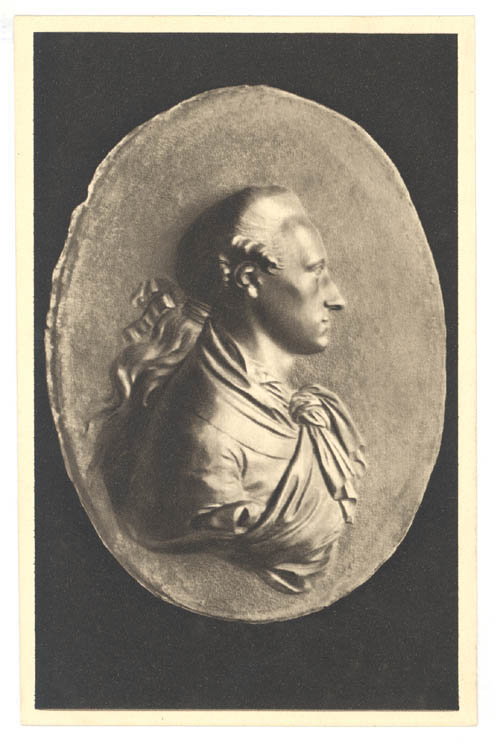
1.1 Contemporary Goethe sculptures
Melchior 1775
NOTE:To zoom in, double-click the pictures.
JP Melchior, 1774-75
Verso: First relief by Johann Peter Melchior [1742-1825] 1774-1775. Goethe in plastic. Signet. Publisher Alt-Weimar, Weimar.
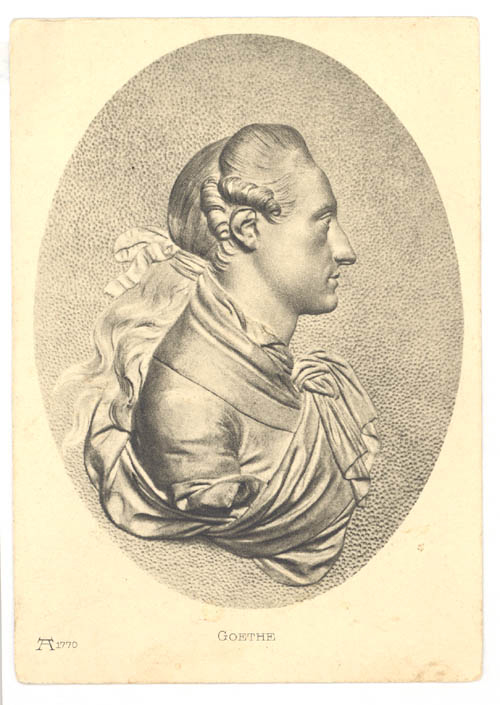
Verso: GOETHE, modeled in 1775 by JP Melchior (Goethe National Museum, Weimar) FA Ackermanns Kunstverlag, GmbH, Munich, No. 1770 –
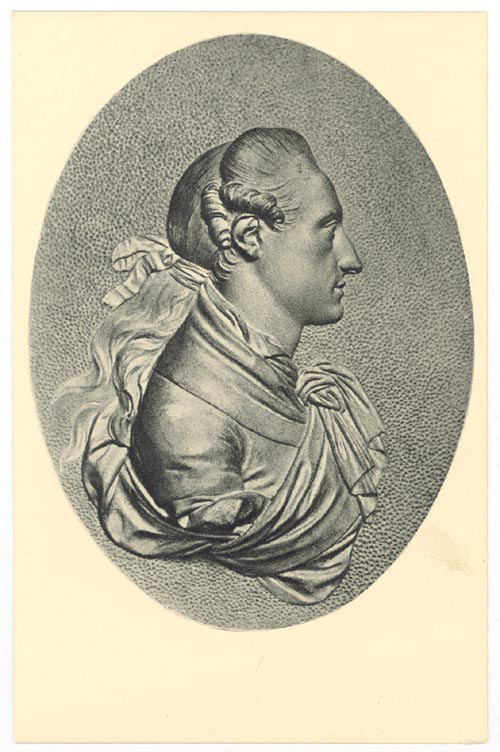
JP Melchior, 1779
Verso: Goethe, modeled in 1779 by JP Melchior. FA Ackermann’s Kunstverlag, Munich. Series 147 (12 cards). No. 1770. – Payer-Thurn, n. 51. Election, n. 9. Verso: “The author of the sufferings of young Werther by his friend Melchior, 1775.”
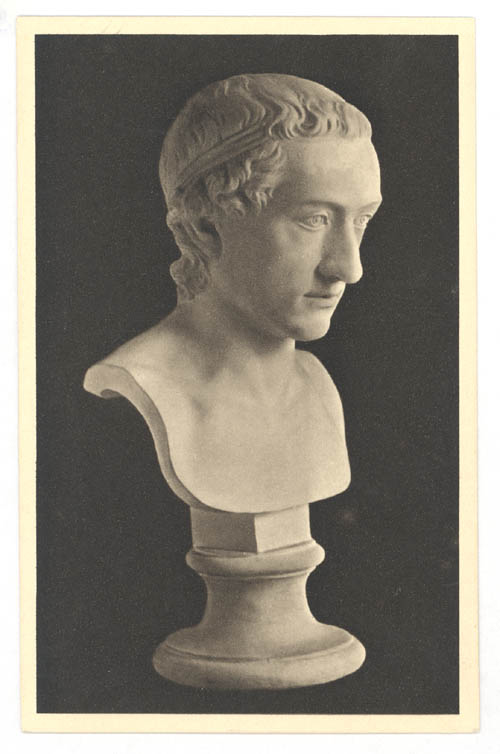
MG Klauer, 1780
Verso: Bust by Martin Gottlob Klauer [1742-1801] c. 1780. Goethe in plastic. Signet. Publisher Alt-Weimar, Weimar. – Election, no. 18. Further Goethe busts of Klauer (around 1780), see Wahl / Kippenberg, p. 77.
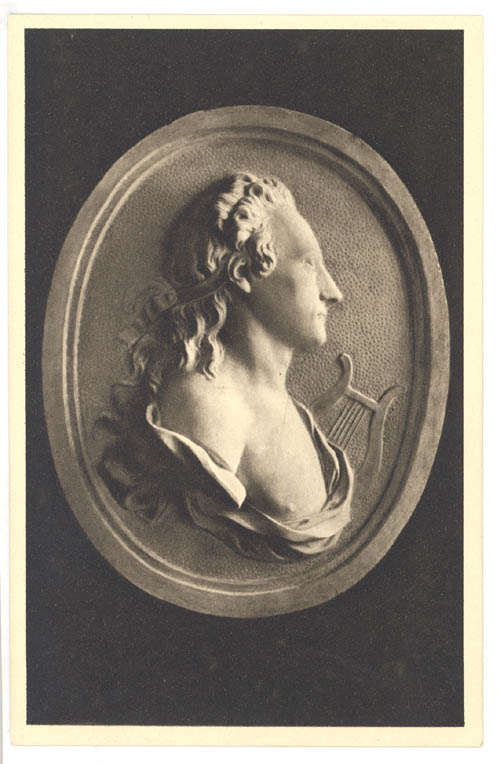
Melchior 1785
JP Melchior, 1785
Verso: Second relief by Johann Peter Melchior 1785. Goethe in plastic. Signet. Publisher Alt-Weimar, Weimar.
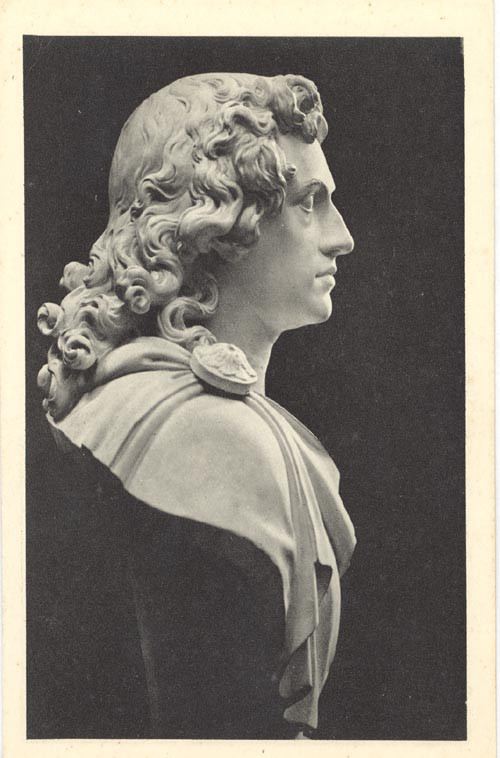
Trippel 1787
A. Trippel, 1787/90
Verso: Weimar, Goethe National Museum. Goethe. Bust of Alexander Trippel [1744-1793]. Rome, 1787, No. 634. L. Held, Hofphotogr. Weimar, Marienstr. 1. Tel. 432. – Goethe and the Arts, p. 182 Fig. 131. Payer-Thurn, n. 114 (facial mask). Choice, No. 31. Wahl / Kippenberg, p. 126.

A. Trippel, 1787/90
Verso: Alexander Trippel: Goethe (Marble Coast). Signet. Publisher Alt-Weimar, Weimar.
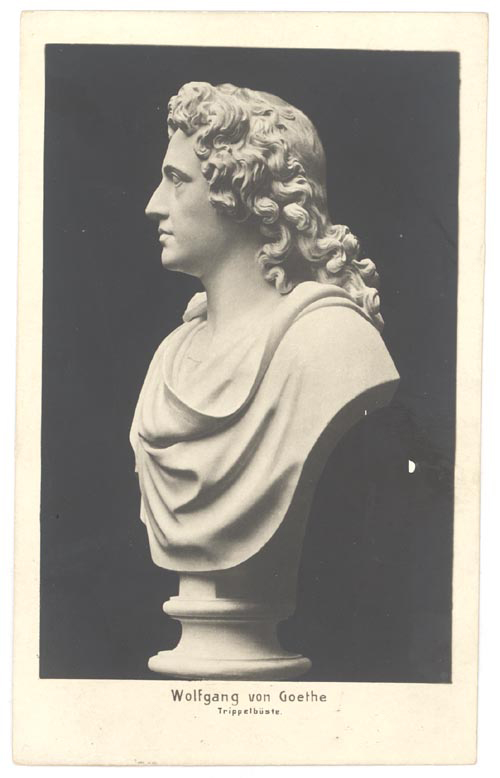
A. Trippel, 1787/90
Wolfgang von Goethe. Triple bust Verso: Postcard.
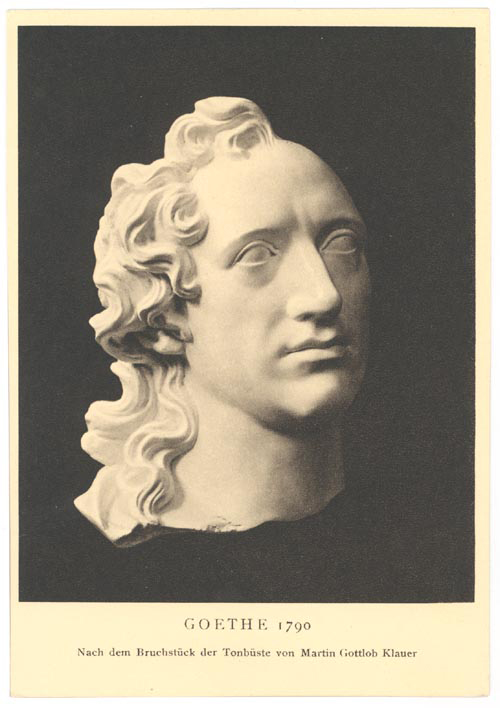
Klauer 1790
MG Klauer, around 1790
GOETHE, 1790. After the fragment of the Tonbüste by Martin Gottlob Klauer. Verso: Published by Berger, German Book and Art Publishers, Dresden. Published with the permission of the Goethe National Museum, Weimar. Produced by F. Bruckmann AG Munich. Election, nos. 33 and 34. Further Goethe busts of Klauer (c. 1780), see Wahl / Kippenberg, p. 77.

Klauer 1790 b
MG Klauer, around 1790
Verso: Fragment of the bust of Martin Gottlob Klauer about 1790. Goethe in plastic. Signet. Publisher Alt-Weimar, Weimar.
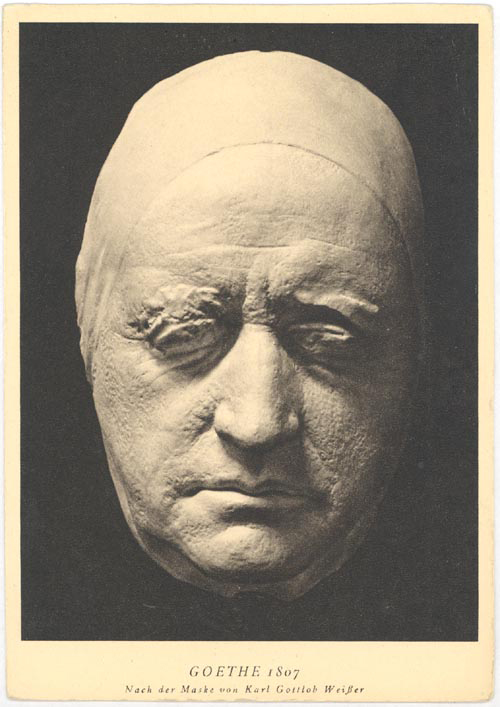
Weisser 1807
- KG White, 1807
GOETHE 1807. According to the mask of Karl Gottlob Weißer [1779-1815]. Verso: Published by Berger, German Book and Art Publishers, Dresden. Manufactured by F. Bruckmann AG Munich. Not running. “The mask is the only facial cast ever taken from Goethe.neither Schadow [cf. No. 14] has made a new facial print in 1816, The sculptor Weisser, Schadow, Rauch, and Tieck have, in a very different manner, laid the mask upon their busts. “” The mask is the only one that is beyond the subjectivity of the fine artist. ” (P. 280) Repeated reflections, p. 479: “The literary, much-attested asymmetry of the facial features and the specific shape of the skull bones are so clearly reproduced as scars and folds as traces of the long, fulfilled life.”
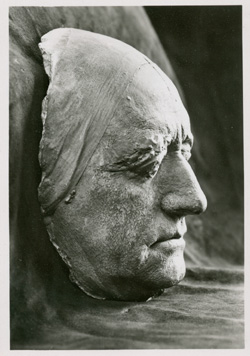
Weisser Gesichtsmaske Held
11a. Goethe. From Weisser mouldable facemask 1807.Louis Held, court photographer, Weimar.
Weisser 1807
Living mask of Goethe, 1807
Verso: face mask of Goethe. 1807 manufactured by Weißer. Goethe National Museum, Weimar.
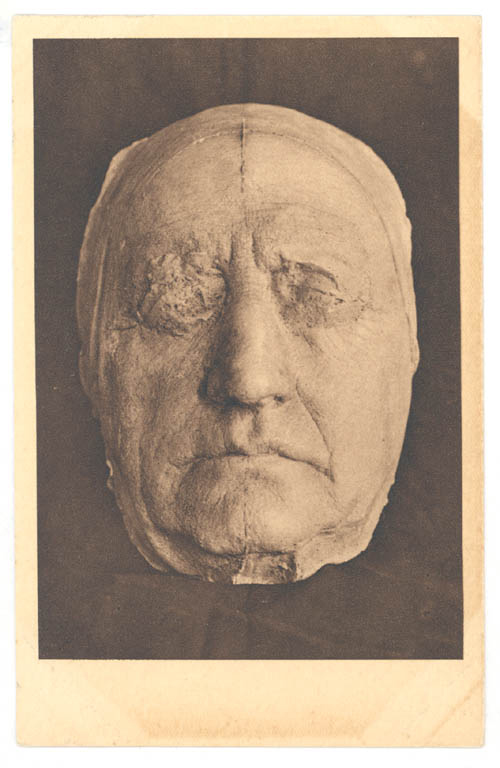
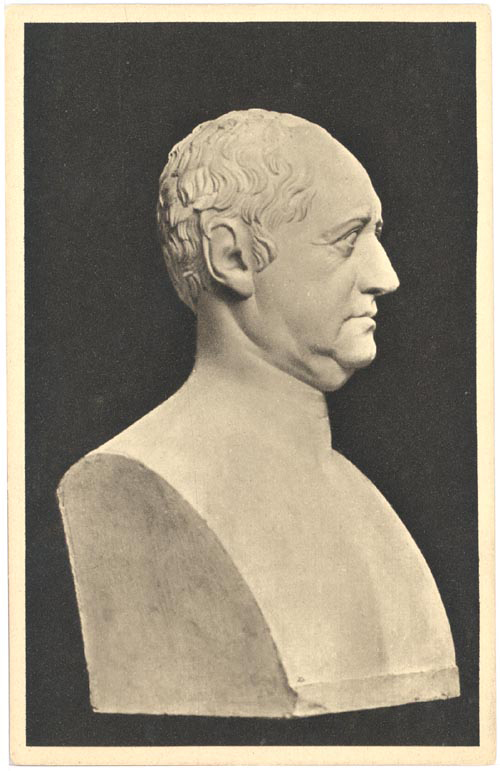
Weisser Bueste 1807
KG White, 1807/08
Verso: Bust by Karl Gottlob Weisser 1807-1808. Goethe in plastic. Signet. Publisher Alt-Weimar, Weimar. – Election, no. 44.
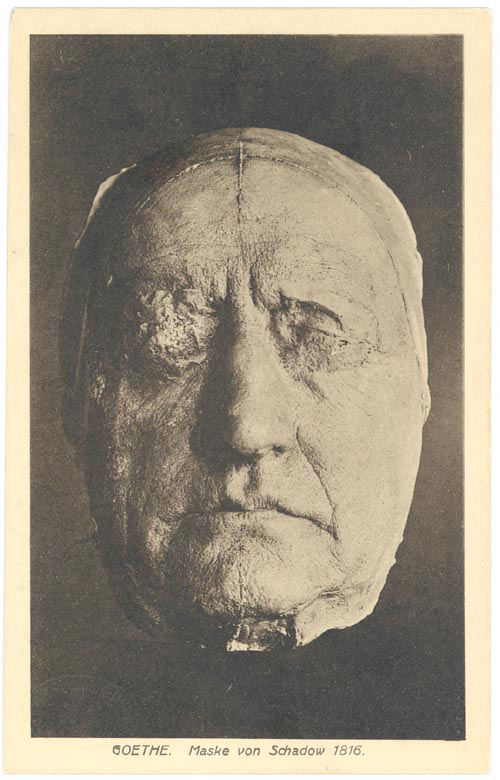
Schadow 1816
JG Schadow, 1816
GOETHE. Mask of [Johann Gottfried] Schadow [1764-1850] 1816. Prepress temple: Goethe National Museum Weimar. Verso: From the Goethe House in Weimar. Ph. Louis Hero, Weimar. – Payer-Thurn, no. 149.
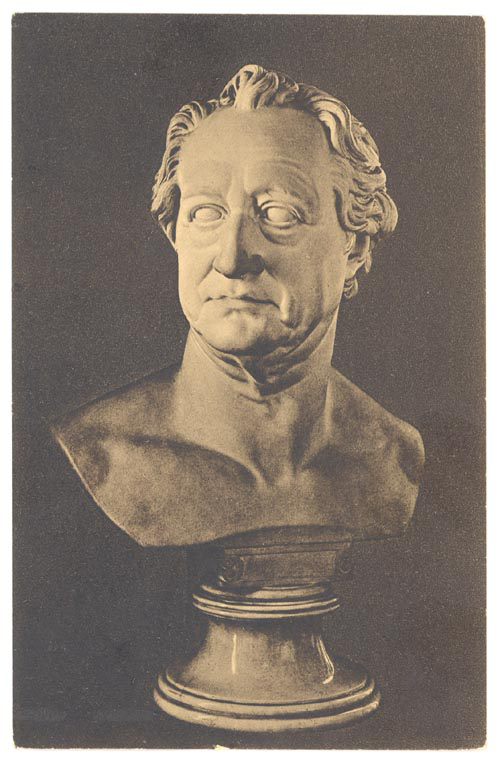
Rauch 1820
15th c. D. Rauch, 1820
Verso: FA Ackermann’s Kunstverlag, Munich. Series 115: 12 Goethe Portraits. No. 1450: The Goethe bust of C [hristian] D [aniel] Rauch 1777-1857. Not running. Goethe, and the art, p. 184. “The similarity of this portrait,” writes Heinrich Meyer, “hardly leaves anything else But he also succeeded in satisfying the demands of the higher art, and not only did the artist achieve a very lively, lively turn of the head, but he also knew how to enlighten the features of the face and bring to the whole the most praiseworthy agreement. Election / Kippenberg, p. 206.
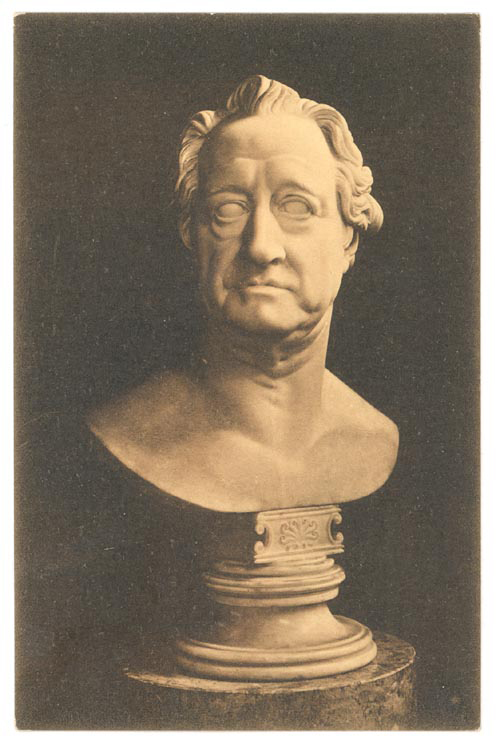
Rauch 1820 b
16th century, D. Rauch, 1820
Verso: Leipziger Museum, No. 248. Christian Daniel Rauch: Portrait of Goethe. Publisher of Fischer & Ludwig Leipzig. A comparison of nos. 15 and 16 shows deviations of the replicas.
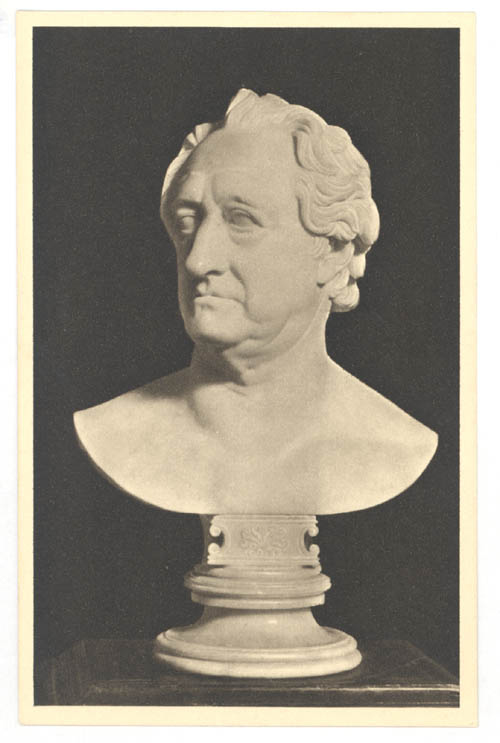
Rauch 1820 c
17th century, D. Rauch, 1820
Verso: Bust by Christian Daniel Rauch 1820. Goethe in plastic. Signet. Publisher Alt-Weimar, Weimar.
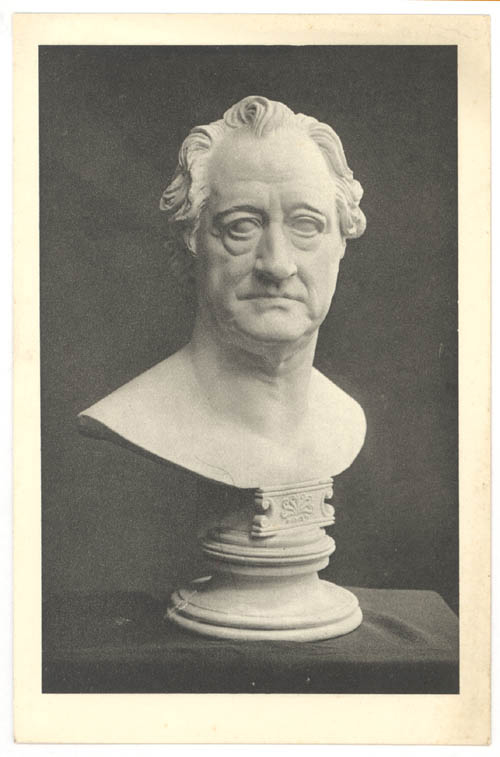
Rauch 1820 d
18th century, C. Rauch, 1820
Verso: Goethe. Bust of Rauch, Jena 1820. Weimar, Goethe National Museum. 642 L. Held, Hofphotogr. Weimar, Marienstr. 1, tel. 432.
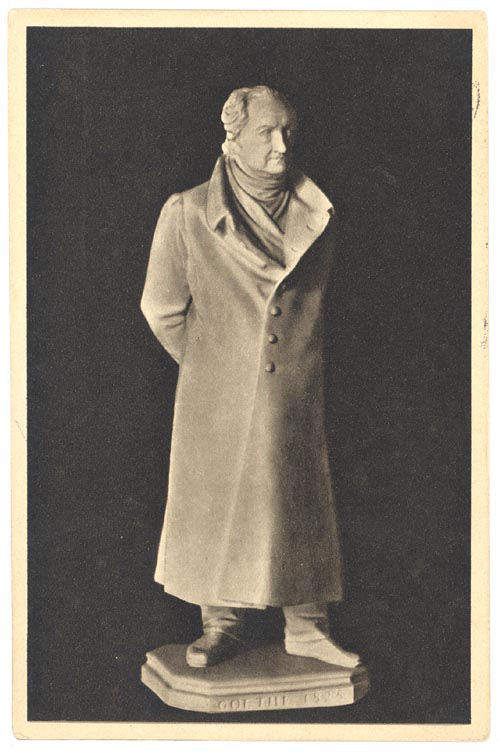
Rauch 1828
19th c. D. Rauch, 1828
Verso: Statuette by Christian Daniel Rauch 1828. Goethe in the plastic. Signet. Publisher Alt-Weimar, Weimar. Postmark: 9.5.37. – Election, No. 71. Election / Kippenberg, p. 206.
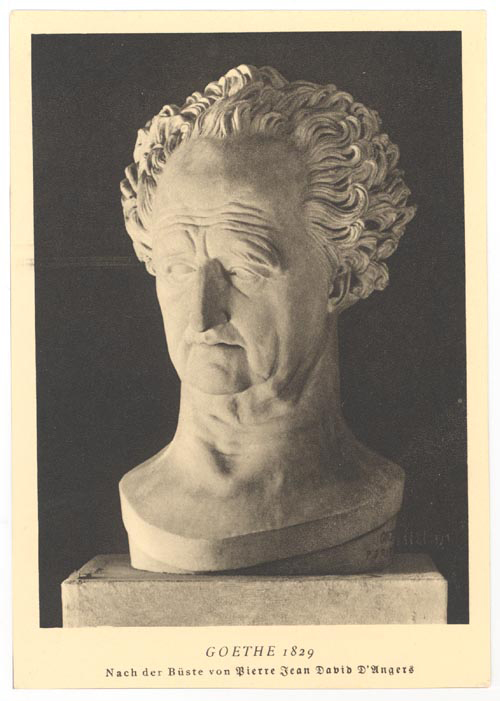
D Angers 1829
PJD D’Angers, 1829
GOETHE 1829. After the bust of Pierre Jean David D’Angers [1788-1856]. Verso: Published by Berger, German Book and Art Publishers, Dresden. Published with the permission of the Goethe National Museum, Weimar. Manufactured by F. Bruckmann AG Munich. – Goethe and Art, p. 187 Fig. 136. Payer-Thurn, no. 175. Election, no. 72 (with base). Wahl / Kippenberg, p. 227 (with base).
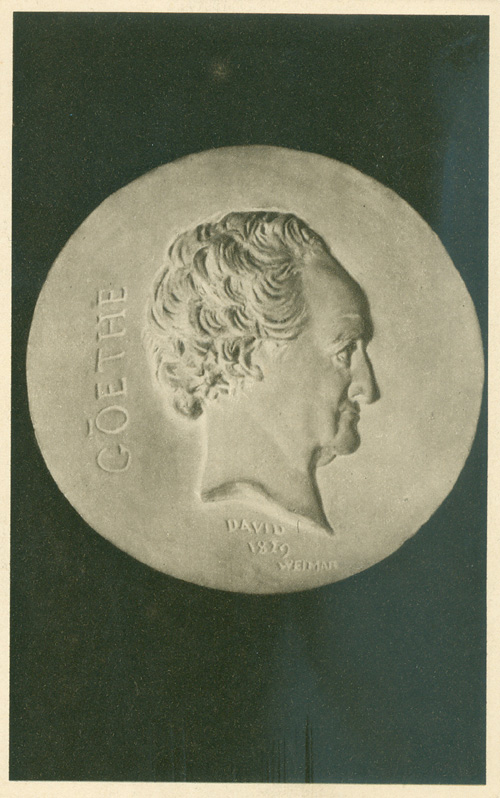
David Goethe Alt Weimar
20a. PJ David d’Angers, 1829
Verso: Goethe in plastic. Relief from Pierre Jean David d’Angers, 1829. Publisher Alt-Weimar, Weimar.

Facius Goethe Alt Weimar
20b. A. Facius, 1825-1830
Verso: Goethe in plastic. Relief from Angelica Facius between 1825 and 1830. Publisher Alt-Weimar, Weimar.

Schiller – Schaedel
1.2 Posthumous Goethe sculptures
NOTE:To zoom in, double-click the pictures.
Goethe, when looking at Schiller’s skull, 1897
Socket row: Secret vessel! Spelling oracles. / How am I going to hold you in my hands? / Goethe by looking at Schiller’s skull. Weimar, Goethehaus “Goethe when looking at Schiller’s skull”. Verso: 1801 Publisher of Zedler & Vogel, Darmstadt.
The 1.10 m high bust was created by Gustav Eberlein [1847-1926] 1897 without order, the Gipsoriginal is owned by the Museum Weimar classic. “The bust was shown in 1898 as a gypsum model in the Grand Berlin Art Exhibition and in the Munich International Art Exhibition and in 1905 as a marble exhibition in Berlin.” Rolf Grimm: Eberlein, a glowing admirer of Goethe. URL: http://www.hann-muenden.net/spontan/eb_goet2.htm .
“Schiller’s body was first set up in a vault of the Jacobskirchhof in Weimar, which had to be cleared in March 1826. The mayor was summoned to find Schwabe Schiller’s bones among the mass of the remaining buried there, the skull was provisionally on the 17th September 1826 on the Grand Ducal In the solemn act, in which he himself did not participate, Goethe composed the wonderful Terzines, “Considering Schiller’s Skull.” Payer-Thurn, Explanation to No. 183. For six months Goethe preserved Schiller’s skull. Cf. Albrecht Schöne: Schiller’s skull. Munich: CH Beck 2002.
In serious ossuary was it where I gazed,
fit Like Skulls skulls arranged;
The old time I thought, the gray.
They stand in line clamped, the otherwise hated each other,
and rough bone, the fatal beating each other,
you are crosswise, tame to rest all hier.
Entrenched shoulder blades! what they wore,
nobody asks, and dainty-tät’ge members,
the hand, the foot, scattered from life joints.
Your tired so lagt down in vain,
not repose in the grave was allowed to drive you,
you come up to the light of day again,
and no one can love the dry shell,
Welch splendidly fine core kept them well.
But me adepts was written Scripture,
the sacred sense undisclosed anyone
When I midst of such rigid amount
Invaluable gorgeous saw a Gebild,
That in the room Moderkält ‘and Enge
I freely and heat feeling refreshed me,
as if a fountain of life to death sprang,
as me mysteriously delighted the form!
The god-inspired trail, which is preserved!
A look that carried me to that sea,
The flutend flows increased figures.
Secret vessel! Oracles donating
How am I worth to keep you in hand,
you most treasure from Moder pious entwendend
And in the open air to free the senses,
to sunlight reverently turning towards me.
What can man in life attract more,
as that God-nature manifest him?
How it can trickle to spirit the celebrations
as they keep the spirit generated fixed.
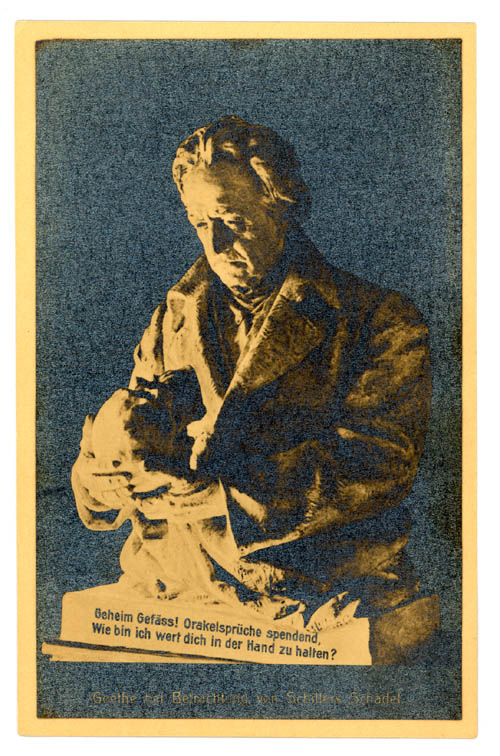
Schiller – Schaedel b
Goethe, when looking at Schiller’s skull, 1897
Goethe looking at Schiller’s skull. Pedestal: Secret vessel! Spelling oracles. / How am I going to hold you in my hands? Verso: Publisher: F. Feuerstein Nachflg., Weimar.

Goethe Betrachtung von Schillers Schädel
22a. Goethe looking at Schiller’s skull
Goethe looking at Schiller’s skull. Dr. Trenkler Co., Leipzig. 1905. Wei. 23.

Epple
Epple
Verso: Goethe. According to the sculptor [Emil] Epples [1877-?] Hermen im Kgl. Court Theater in Stuttgart. Artist Postcard. Folder 206/2 poets and composers. L. Schaller, Kunstverlag, Stuttgart (founded in 1860). Signet.
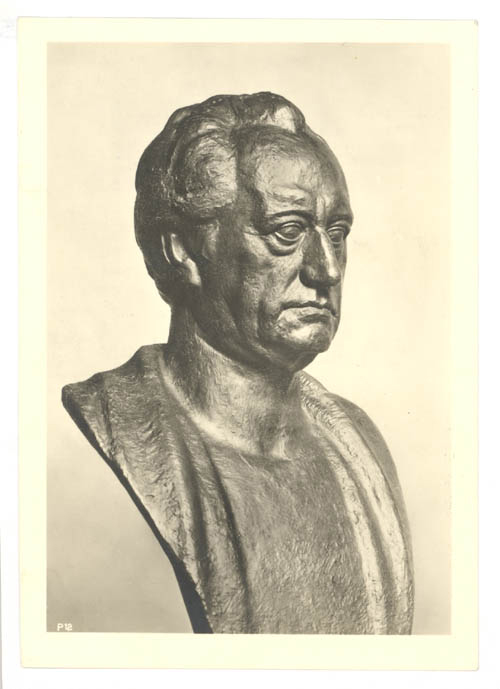
Mueller
G. Mueller
P12. Verso: Prof. Georg Müller-Munich [1880-1952] “Goethe”. Real dog photo. Publisher Fotostöckel, Hanover.
literature
Goethe and art. Hg. By Sabine Schulze. Ostfildern: Publisher Gerd Hatje 1994 (exhibition catalog Schirn Kunsthalle Frankfurt and Kunstsammlungen zu Weimar).
Payer-Thurn, Rudolf: Goethe. A picture book. His life and work in 444 pictures. Leipzig: Günther Schulz oJ
Pechel, Rud (olf): Goethe and Goethe. 88 pictures (Schaubücher, 32) Zürich, Leipzig: Orell Füssli 1932.
Election, Hans: Goethe in the Portrait. Leipzig: Island of 1925.
Election, Hans / Kippenberg, Anton: Goethe and his world. With the cooperation of Ernst Beutler. 580 pictures. Leipzig: Im Insel publishing house 1932.
Repeated reflections. Weimar Classic, 1759-1832. Permanent exhibition of the Goethe National Museum. Hg. By Gerhard Schuster and Caroline Gille. 2 Bde (with side count). Stiftung Weimarer Klassik at Hanser. Munich, Weimar: Carl Hanser 1999.
3. Legal Notice and Contact
All templates originate from a private collection. The private use and non-commercial use to educational, artistic, cultural and scientific purposes is permitted provided that the source (Goethe time portal) and URL ( www.goethezeitportal.de/index.php?id=425 ) are indicated. Commercial use or use for commercial purposes (eg for illustration or advertising) is only permitted with the express written permission of the author. Contact:
Prof. Dr. Georg Jäger
Ludwig Maximilian University of Munich
Institute of German Philology
Schellingstr. 3
80799 München
Email: georg.jaeger07@googlemail.com

Schwanteich, Gotha, Thüringen, 1805, Frederick William Eugen Döll, 1885 Photo
The monument at the swan pond in Gotha (Thüringen) was a water feature in the park on the former base now the main post

Gotha Altenburg Lodges Certificate Gotha Freemasonry Shown are the Sphinx, and the Anubis referring to Frederich Wilhelm Eugen Döll’s sculpture in Gotha, and Wörlitz
(Gotha-Altenburg lodges certificate) for the Gotha Freemasonry
Shown are the Sphinx, and the Anubis referring to Frederich Wilhelm Eugen Döll’s sculpture in Gotha, and Wörlitz
August Geutebrück was born in 1758 and came to a doctrine on agriculture at the age of 24 years at the service of the ducal family Gotha-Altenburg. Already in the year 1770, he came into contact with Grand Master Ernst II, in 1774 founded Masonic Lodge “to compass”. At least since 1783 August Geutebrück was a member of the lodge, to which also his friend Frederick IV later joined. In 1793, the activities of the Order of Gotha were hired, in 1801 it came to the final resolution of the Gotha Lodge. In 1806, after the death of Ernst II, the lodge was under the name “SERIOUS FOR COMPASS” and reopened. Until shortly before the turn of the century, the Gotha Lodge was in the house Neumarkt No.6. In 1882 the Masonic Lodge was moved to a newly built site, which was next to the Post Office Square. On 15.07. In 1935 the lodge was dissolved by the Gotha THIRD REICH, and all their records were seized.

The Schwanteich (swan pond) was at the point where there is now the rear of the main post office mail. The monument was located on the site of today’s rear building of the community center. It was designed in 1805 by sculptor Frederick William Eugen Döll. A cascade filled the pond with water, the monument stood 25 feet high, was in the form of a portal, consisting of two stones carved with hieroglyphs, each 17 feet high, 6 feet wide, 2 feet deep and over 200 hundred pounds. Within the portal, was a pool, formed from the ibises, up to a fountain, whose jet proceeded to the ceiling and spread a fine rain. The frieze monument was decorated with a winged shield base relief of Isis, and the fluted cornice, a Sphinx resting on the roof of the monument.
After the pond drained and the Imperial Post Office, as well as the building of a new lodge, was built, the monument disappeared. Only the Sphinx remained on the steps of the garden entrance of the lodge but was incorporated by disputes over the ownership of the Sphinx from the demolition company Gebr Eisser. The Sphinx was placed in 1937 first in the garden of the district court of the city, and then in 1948, at the request of older surviving Masons, on the island in the park pond, where seven dead members are buried. The Sphinx is still preserved in its original state.
The monument at the swan pond in Gotha (Thüringen) was a water feature in the park, the former base for the monument is now the main post site.
Schwanteich Gotha Thüringen 1805 Frederick William Eugen Döll
https://sites.google.com/site/geutebrueckdenkmalpark/home
Reconstruction in Gotha digital reconstruction pictures
https://sites.google.com/site/geutebrueckdenkmalpark/bilder/restauration
That was the front of the GEUTEBRÜCK MONUMENT.
Only in a single element description of the monument is in question, of the butterfly image. The detail on a photograph from 1902 – on which only the butterfly could be seen – it is still preserved as above. The top image is a montage but is 100% original condition. The butterfly was a common symbol in that time – it is a sign of resurrection, hope (larva – pupa – butterfly) and thus also the Metarmophose. The butterfly is like the character of the liberated soul from matter.
The inverted flare on the left side of the monument. The torch has not been preserved. The inverted torch is to point out the dying light of life.
There is a palm branch and a laurel wreath on the right side of the monument. The only relief is that the monument is still preserved very well. Symbols of well-deserved fame and finally found peace
The Egyptian Sphinx is predominantly a statue of a male lion with a human head. In the era of classicism sphinxes of more or less Egyptian coinage were a popular motif in art. The Sphinx was in the 18th Century a symbol of eternity, immortality, and the enigmatic. There were 6 sphinxes in Gotha, as far as what is known today. There were probably 2-3 more, but this is no longer recorded.
At the entrance of the Friedhof I was the “old cemetery”, and these two sphinxes standing on the Erbgräbern of Rosenberg and Purgold. The sphinxes were penned by the sculptor Rathgeber.
Rathgeber column on Friedhof II
”
”
In 1838, a smaller Sphinx was seated next to the pillar at the grave of Caroline Rathgeber. The Sphinx is also sculpted by Friederich Wilhelm Eugen Döll. The grave site was part of the pyramidal Rathgeber – family grave.
Lüderitz – Fountain
The sphinxes of medium size, made by Rathgeber, were set in 1840 at the Lüderitz wells (mountain garden), but in 1962 they were removed because hooligans destroyed the sphinxes beyond recognition.
Monument at the swan pond
Schwanteich Gotha Thüringen 1805 Frederick William Eugen Döll
Ruinenberg on Swan Pond
A small hill was near the swan lake until 1820, at the position which today is at the Arnoldi monument. Positioned at the top of the hill were openings for both an external as well as a hidden underground passage. There you could enjoy the most beautiful view under a magnificent tree. At the summit of the hill, a sphinx rested, which seemed to want to follow on to the swan pond the monument. The lower part of the hill has been hiding in the ruins of an ancient temple.
The Loge of Gotha made an attempt to reform German Freemasonry, which was known as the “Association of German Masons,” but historical reform remained unfinished. In 1793, the Duke arranged the lodge activity. In the years 1804 to 1810, he was also the financial manager for Frederick IV, working during the time Frederick IV was in Rome. Frederick IV wrote that the Lord Geutebrück ran the business with perfect order and loyalty. Immediately before his death in 1817, he donated 200 dollars for the Frankenberg `sche hospital. August Geutebrück died on 29.04.1817 in Gotha. The Gotha city archives states: The monument was in the southern part of the English garden of Gotha, five statues, that were probably the most artistic. Duke Frederick IV had the archive secretary and later government Rath August Geutebrück erect the monument in 1820. Frederick IV for the third time in 1814 went to Rome in order to recover from a cramp. When he returned in 1820 to Gotha his friend August Geutebrück, who took care of his finances and business, had been dead for three years. Since he no could not attend his funeral at the old cemetery, he had constructed the last great monument as a proof of his friendship. A year later, at the request of the Freemasons a sphinx on the stone was placed, as a sign of the faithful and close ties with the council of the Lodge “to Ernst compass”, suggesting “Hereafter will solve the dark mystery of life.”. Below the inscription is a butterfly as a symbol of resurrection and metamorphosis. The inverted torch to extinguish, indicating the dying light of life. Laurel wreath and palm, and as symbols of the well-earned fame finally found peace of view. The almost completely weathered inscription on the back reads: “The memory of a brave Biedermanns, on April 29, 1817, the deceased Herzögl.Sächs.Rates August Geutebrück, dedicated by his grateful friend F.”
The oldest preserved photograph of the monument in 1885
The court sculptor Frederick William Doell (1750-1816) was the creator of the sophisticated Sphinx sculpture resting on a base made from Seeberger sandstone. The Sphinx was not made specifically for the base of the monument Geutebrück. It was made already years ago by Doell and after his death in an estate inventory remained in his workshop at Steinmetz. The base was made to match the already existing Sphinx.
By the early 20th. Century, the almost completely weathered inscription and the monument condition in desecration, after violent storm damage in 1928, the Sphinx was erected again properly but had altogether lost by falling the stone headscarf. The four rear hornbeam were uprooted. A bomb explosion in 1945, not far from the monument damaged the Sphinx’s head and damaged the base so that corners were missing completely at the lower end. The other white houses were damaged by the hit and after the war ended were used as firewood. Witnesses of the badly battered sphinx still remember it in the 1950-ies. The Sphinx was highly damaged during a storm by a falling tree, and the Sphinx was removed in 1963.
It was not known until just recently what happened to the Sphinx until it was found in a garbage dump where it was placed under tons of rubble in the 1960s, which was filled in, again and again, only half a meter below the ground. Excavations were not allowed, according to a document from the city archives in Gotha. The Sphinx got there in the dump spring of the 1963rd.
All the text above for the Gotha Altenburg Freemason Lodge is from the website below:
https://sites.google.com/site/geutebrueckdenkmalpark/home
Schwanteich Gotha Thüringen 1805 Frederick William Eugen Döll
___________________________________________________________________




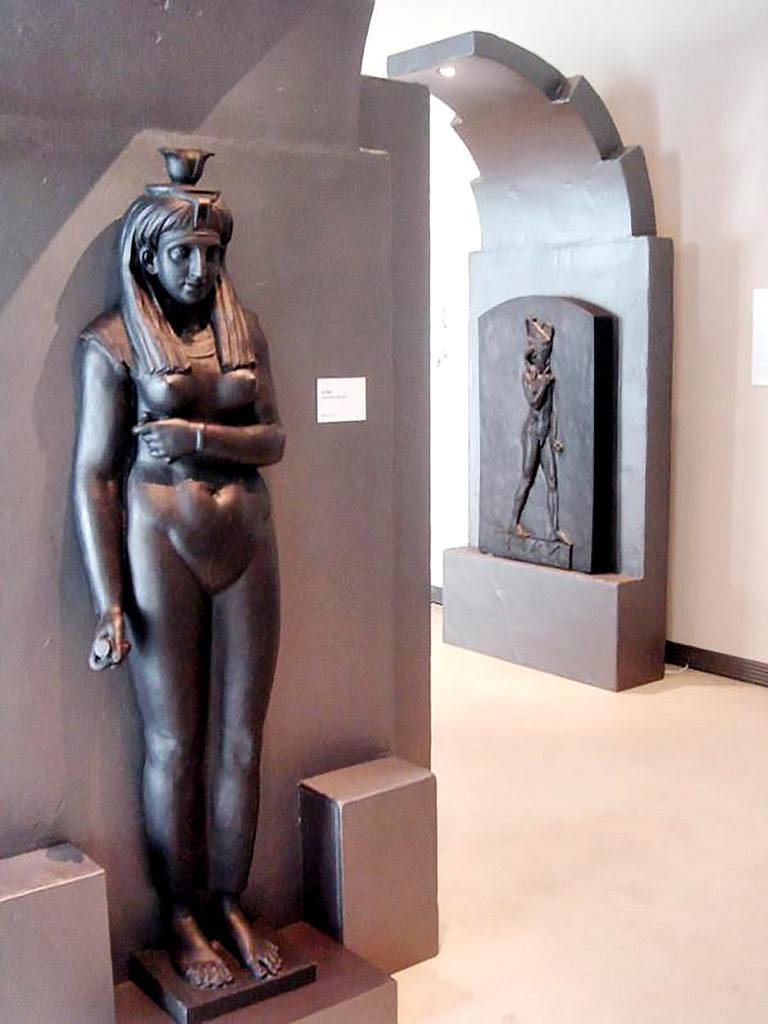

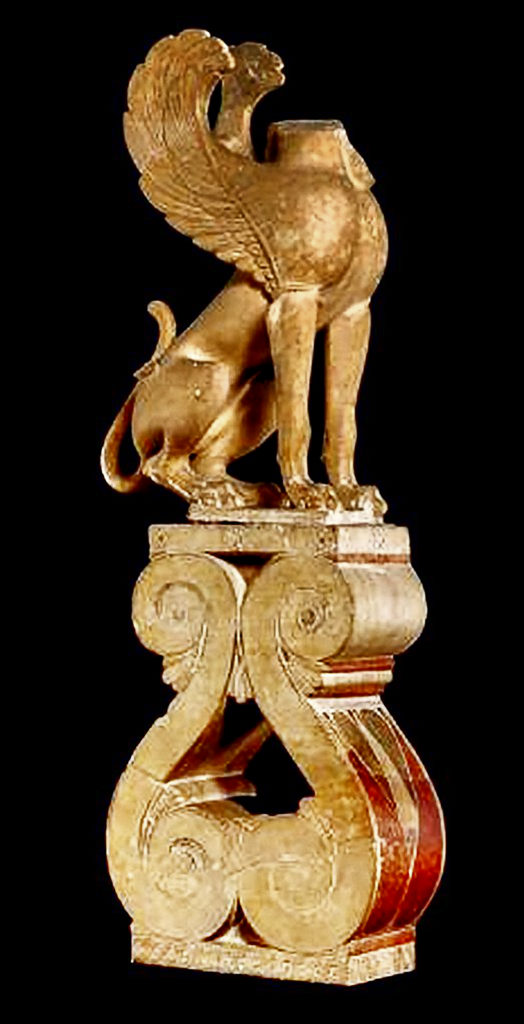
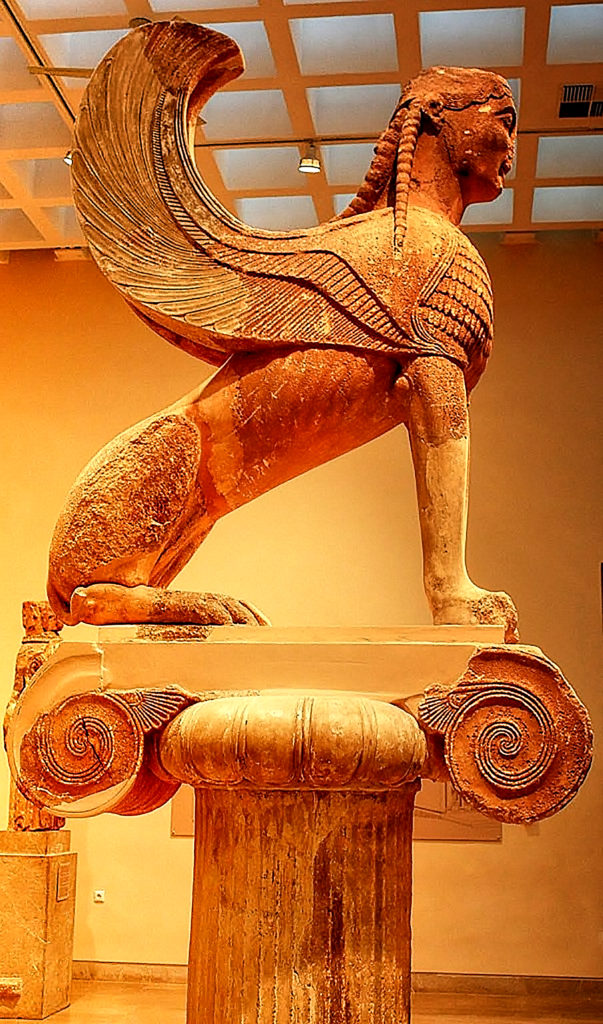
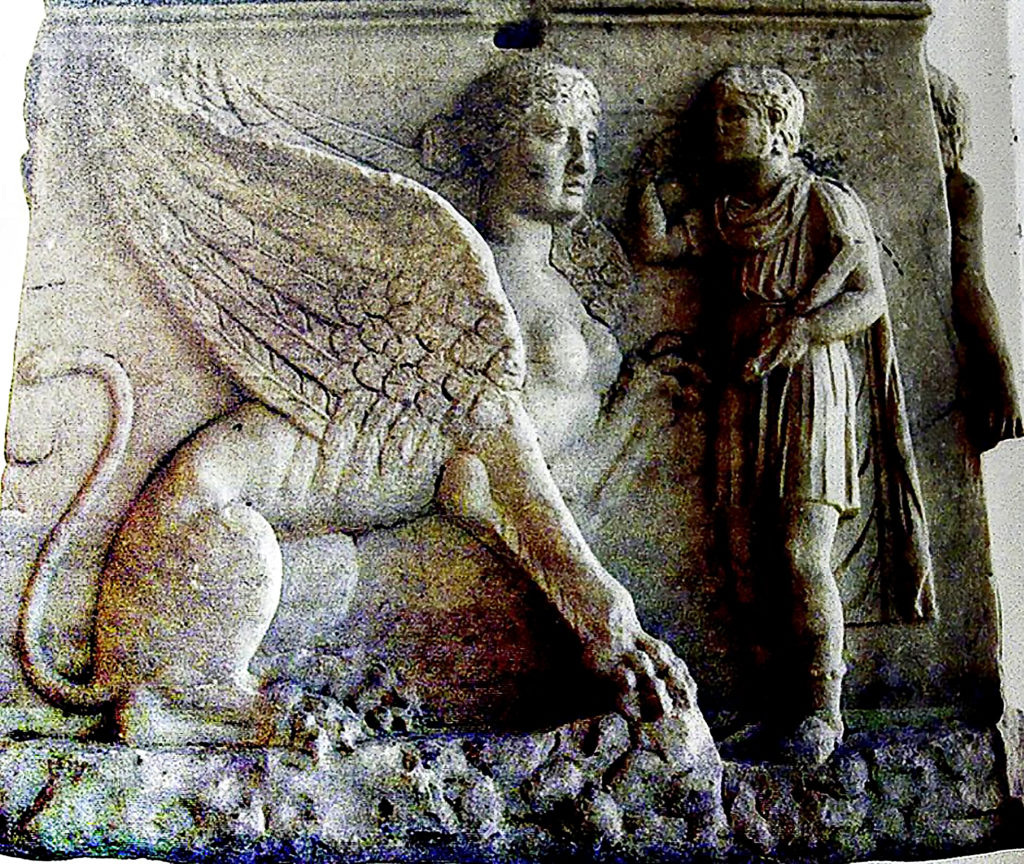
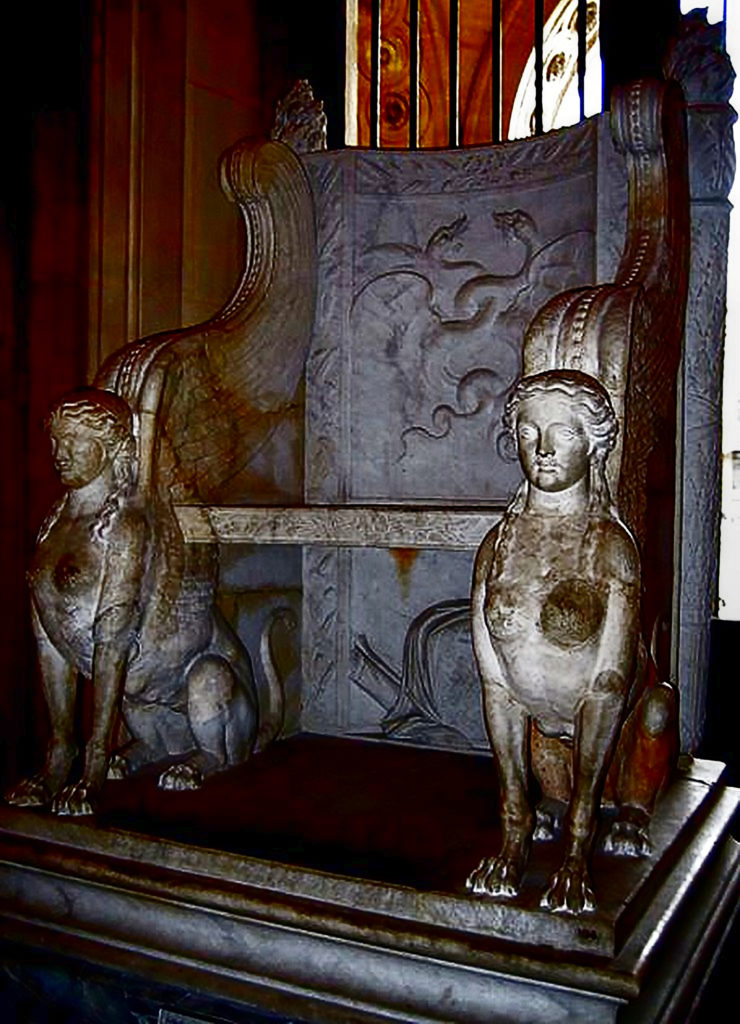
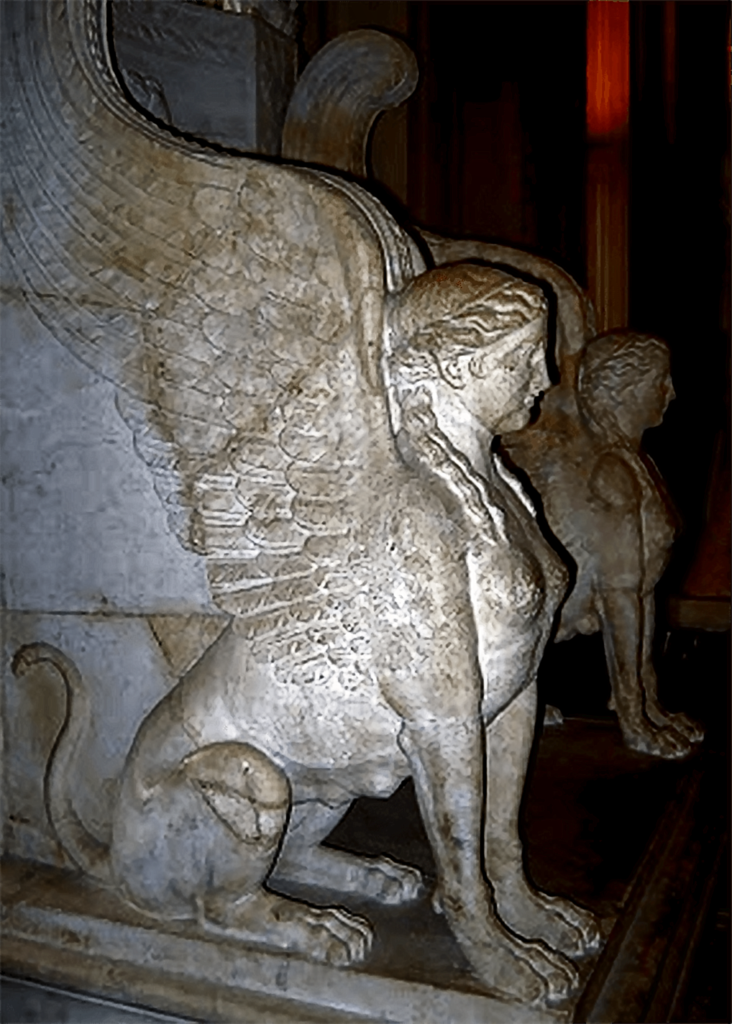
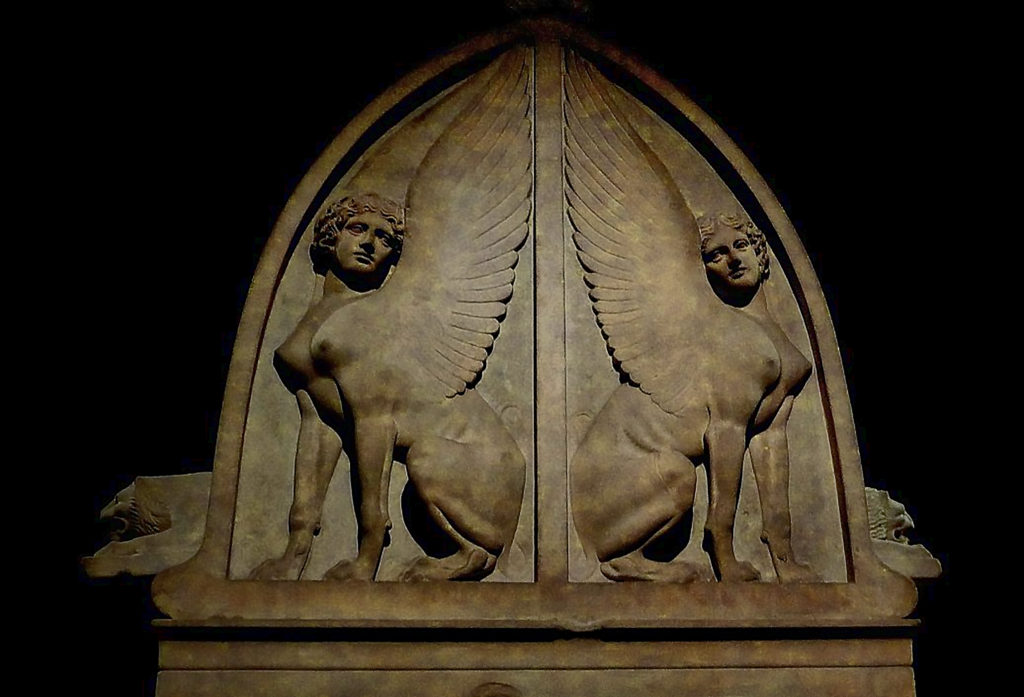
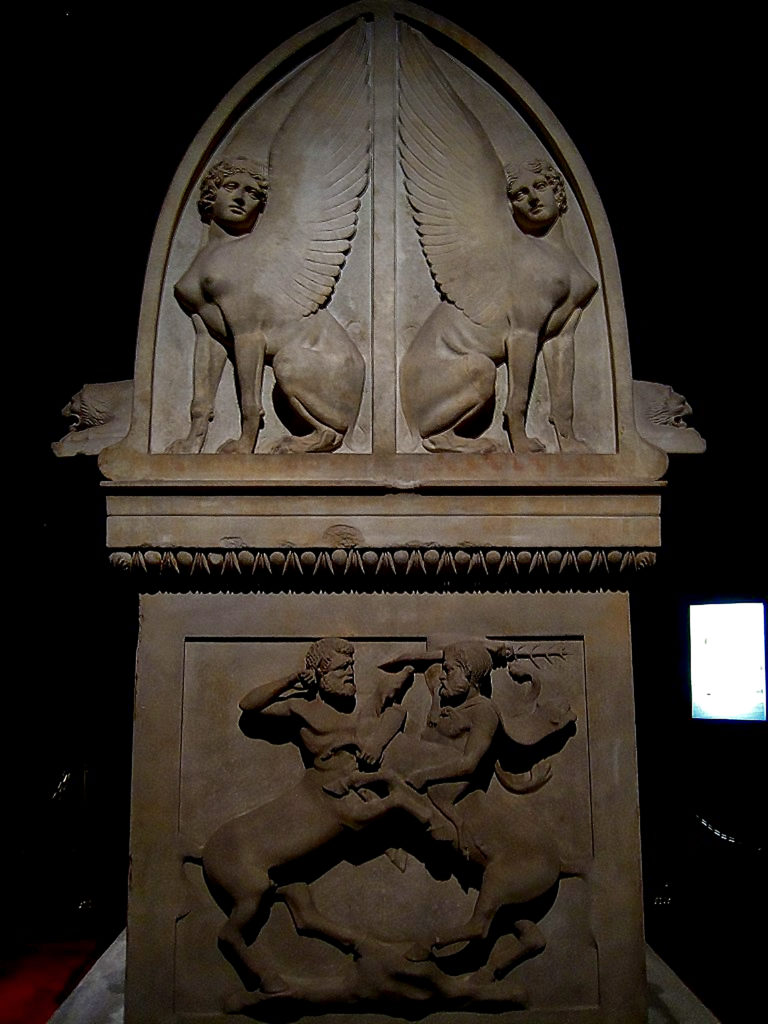
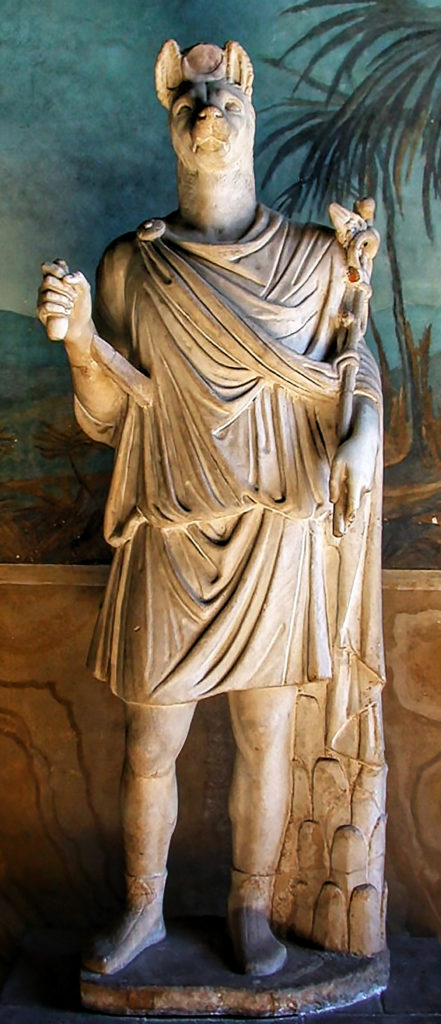
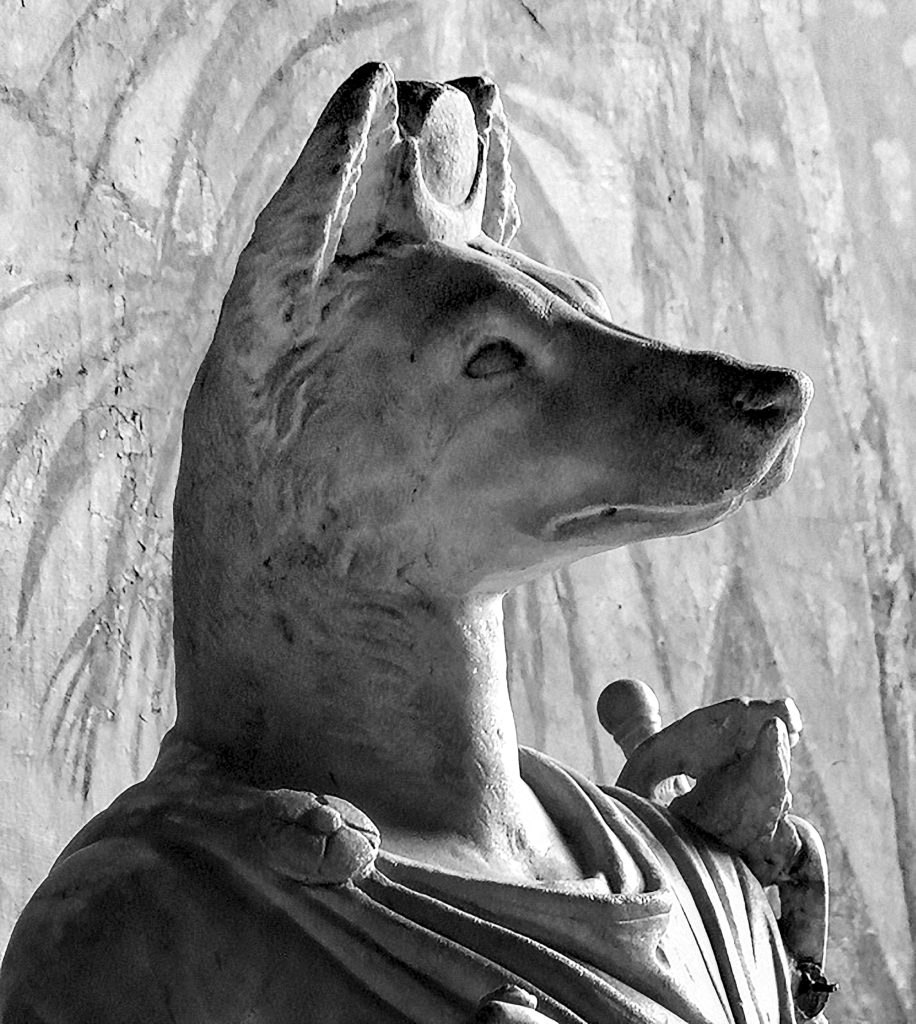
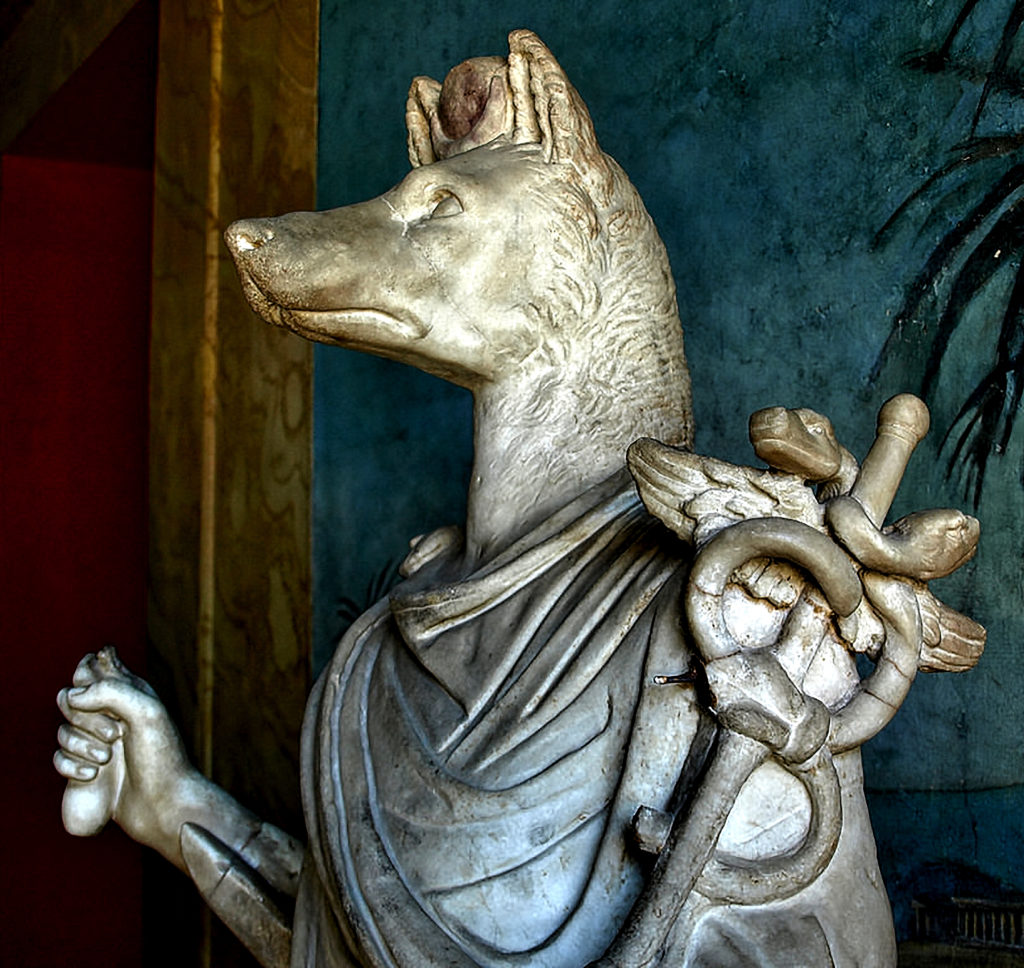
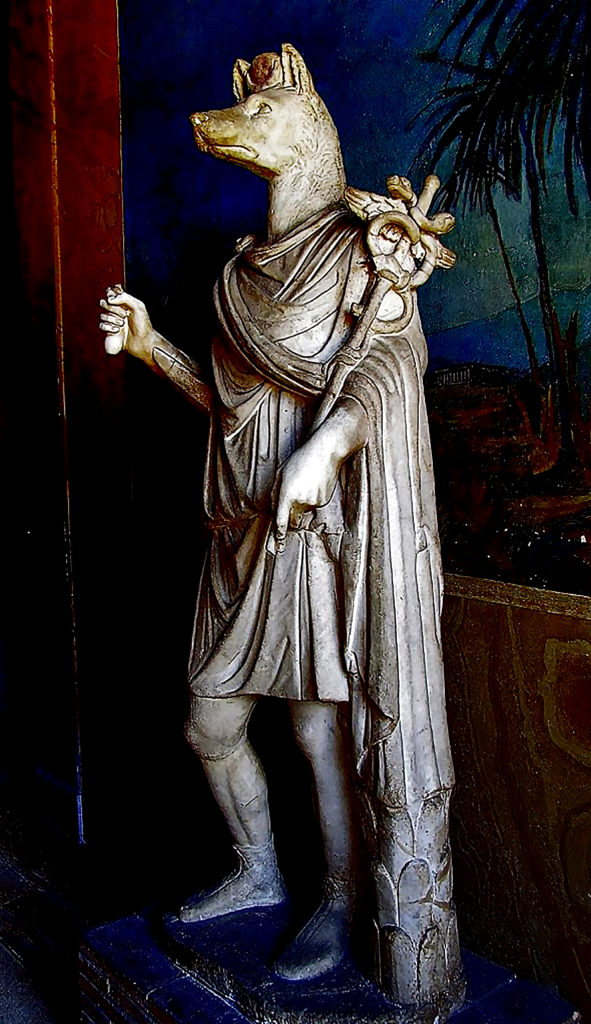
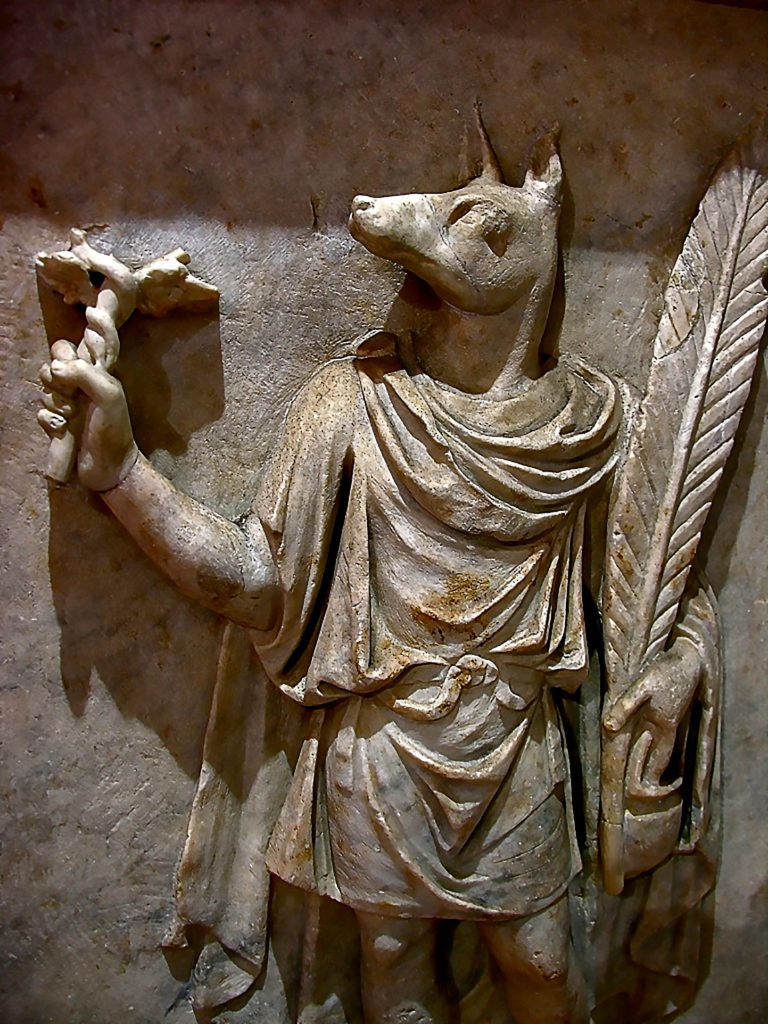
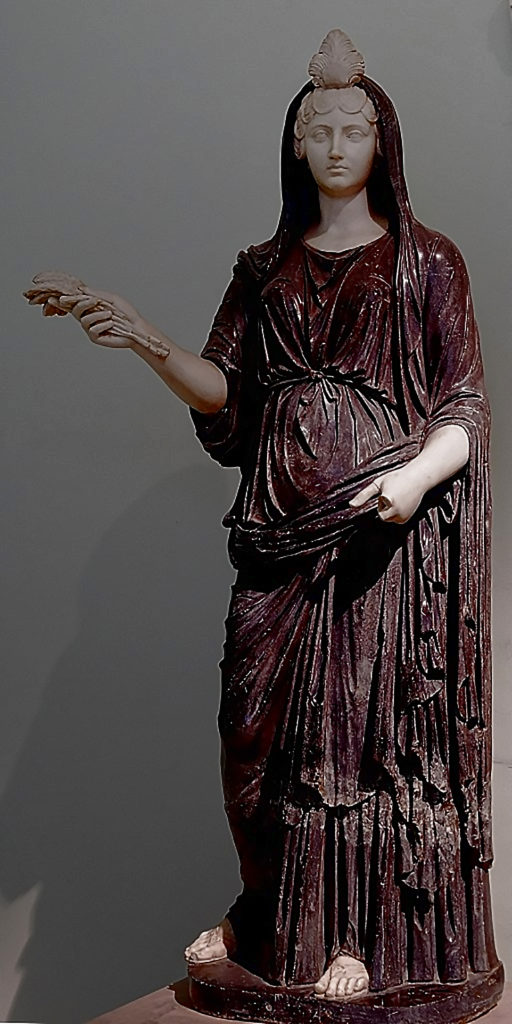
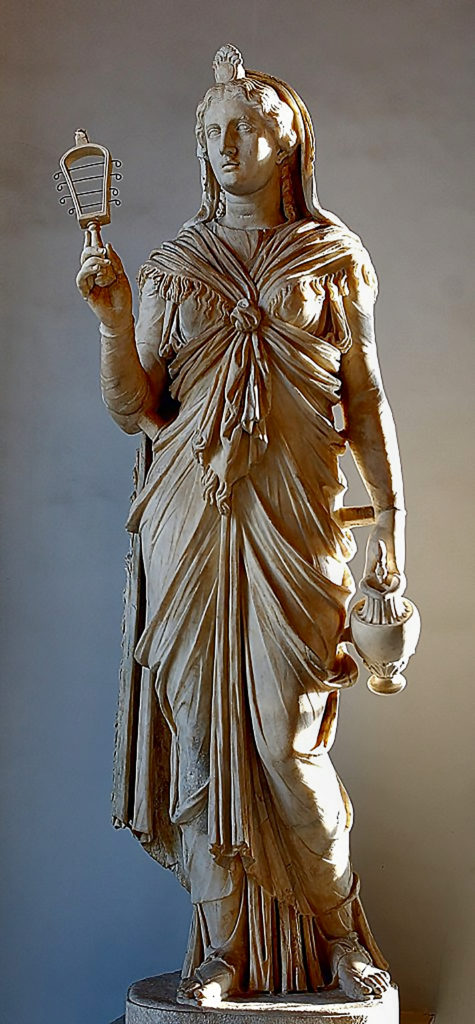

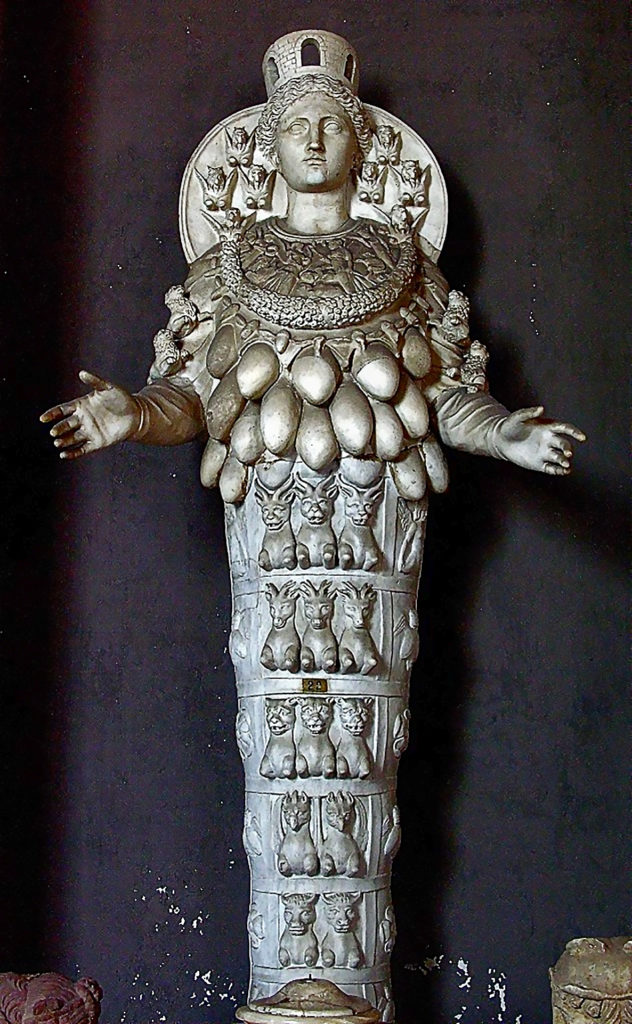
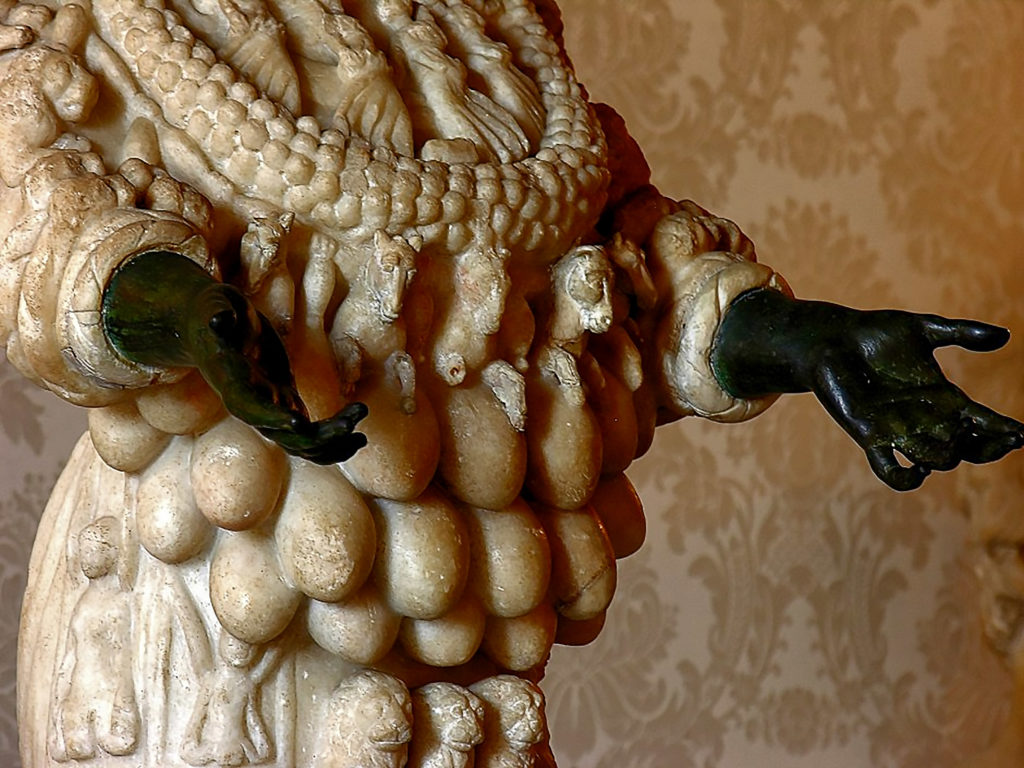
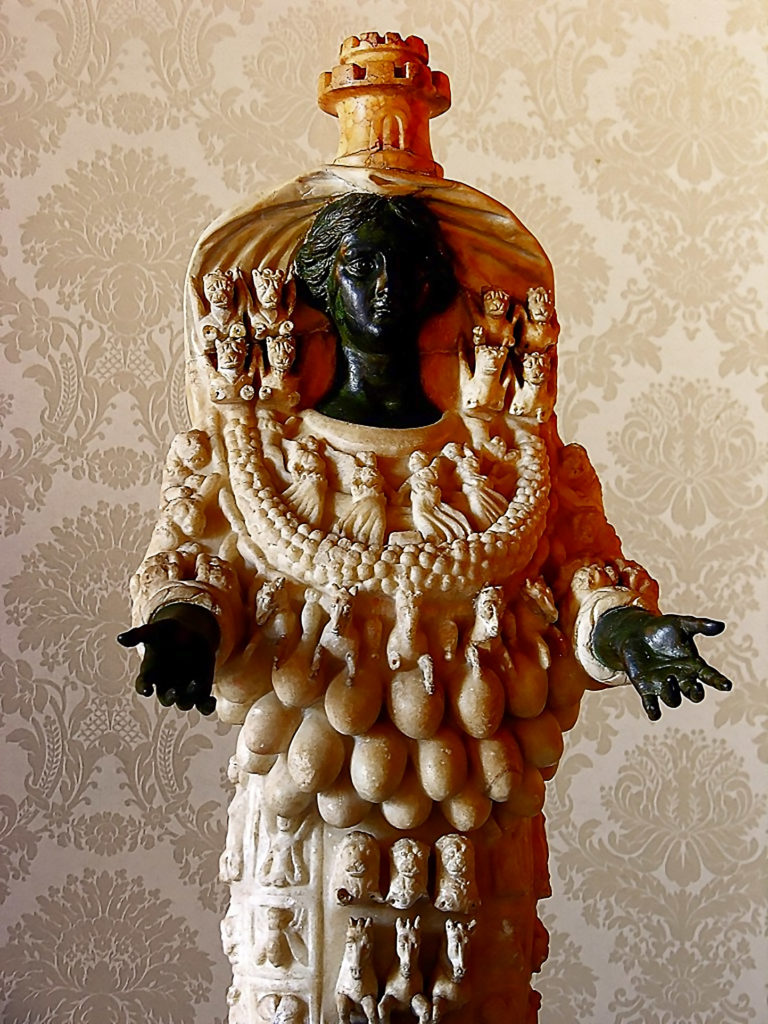
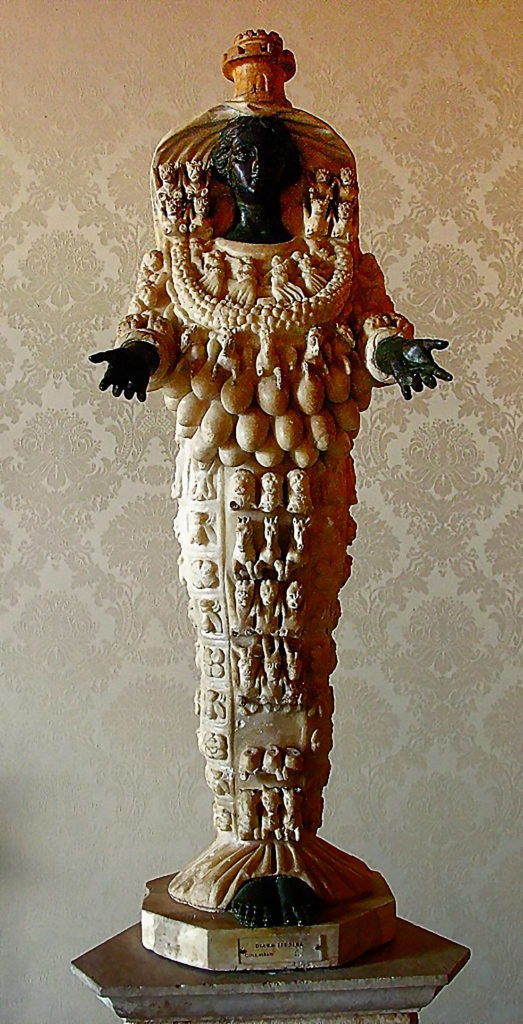
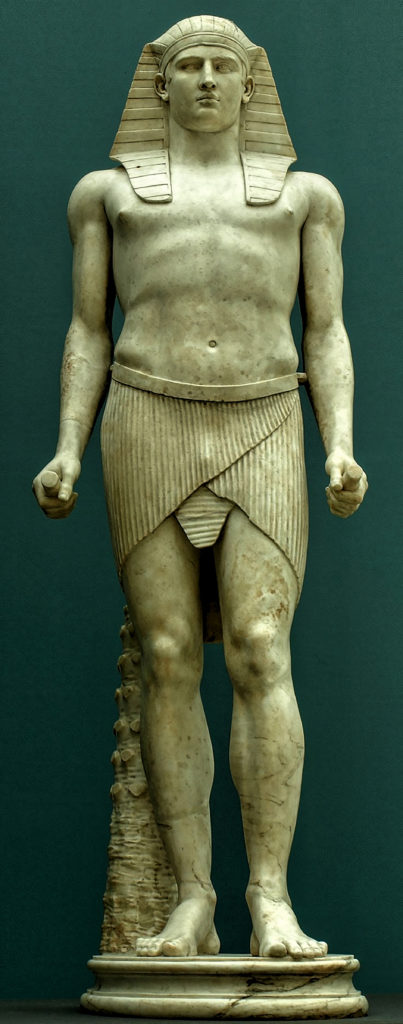
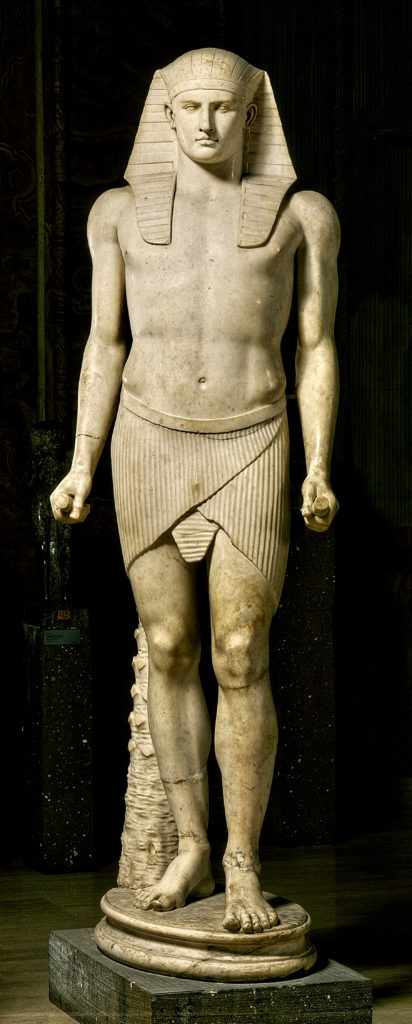
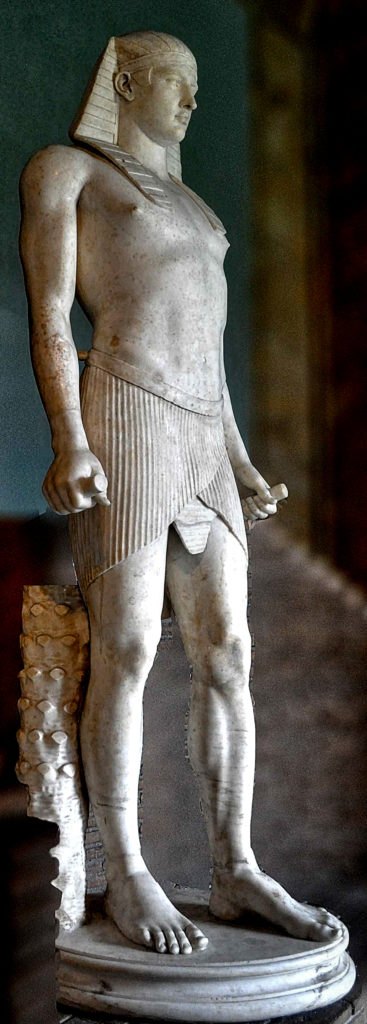
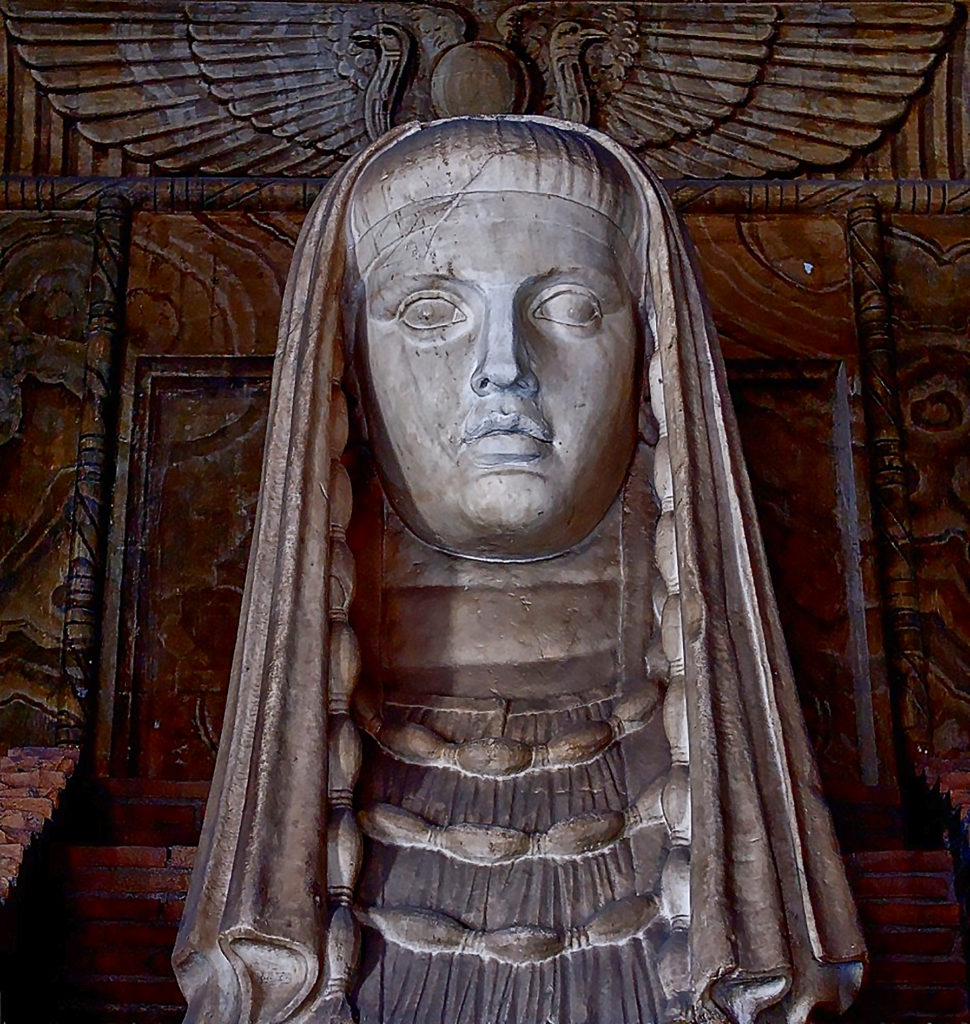
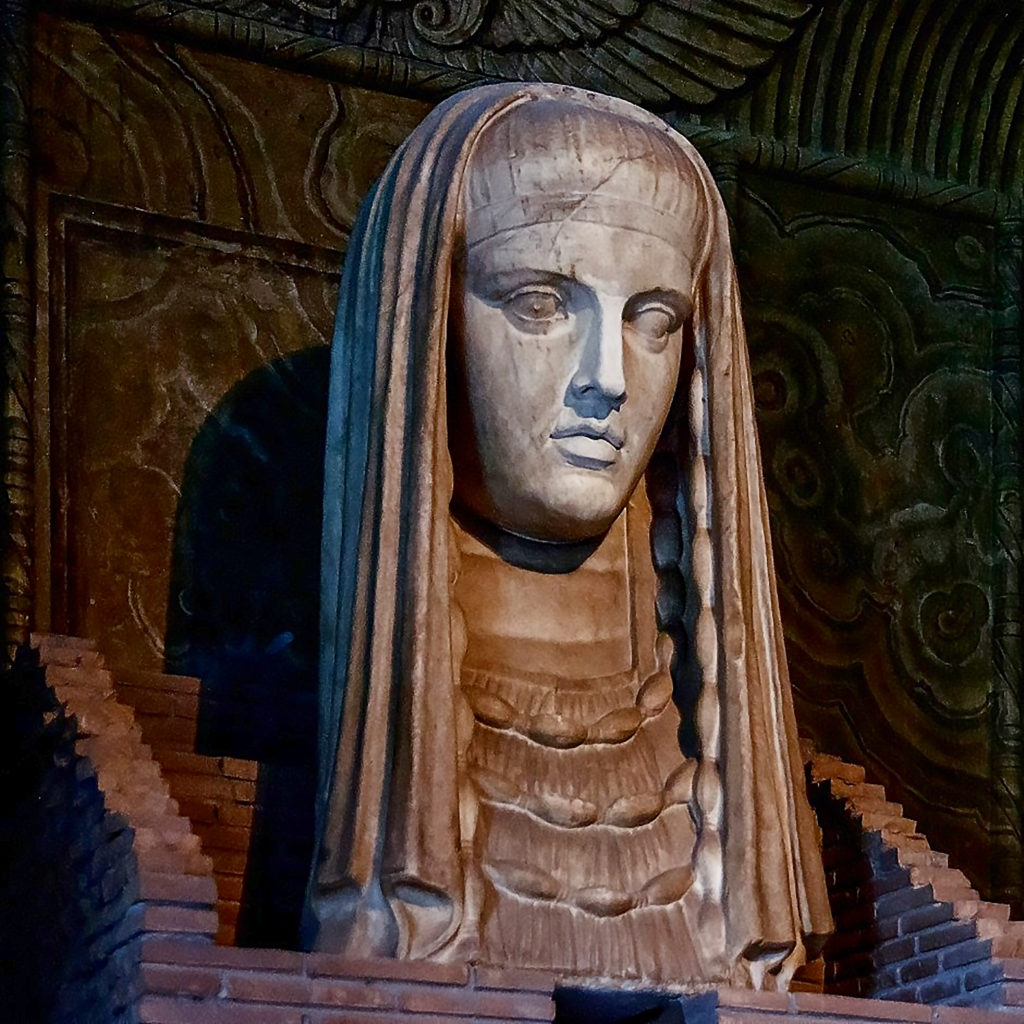
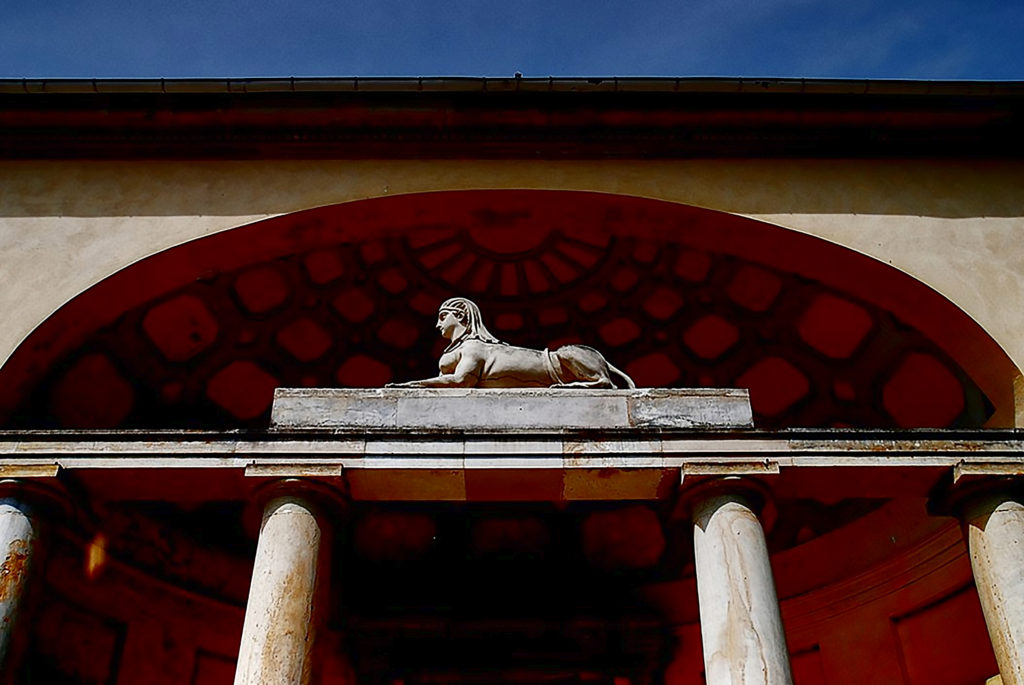
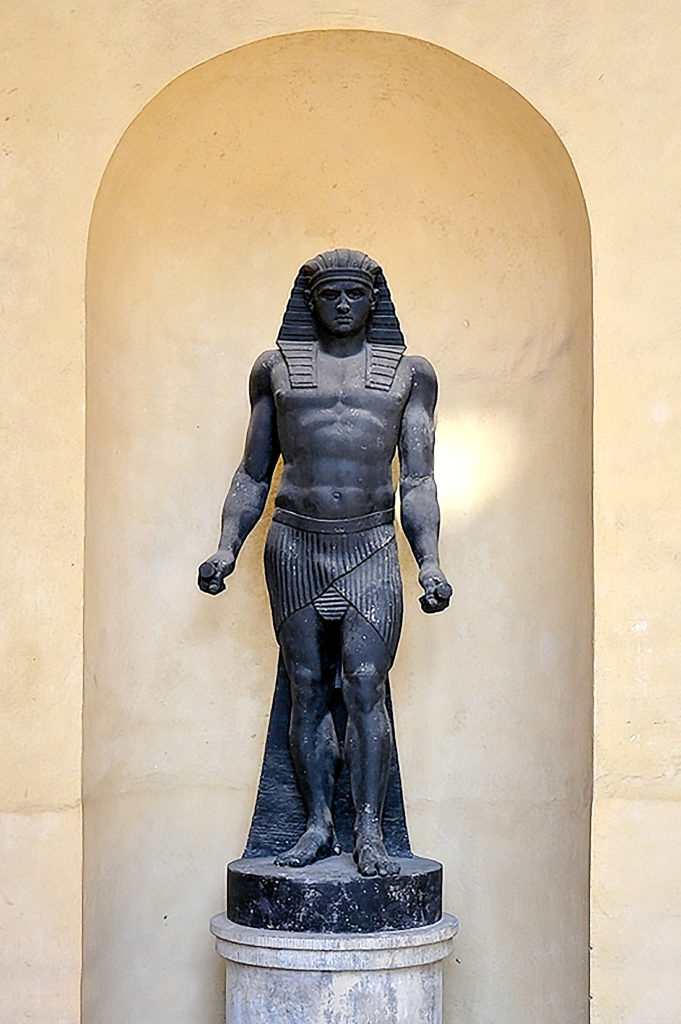
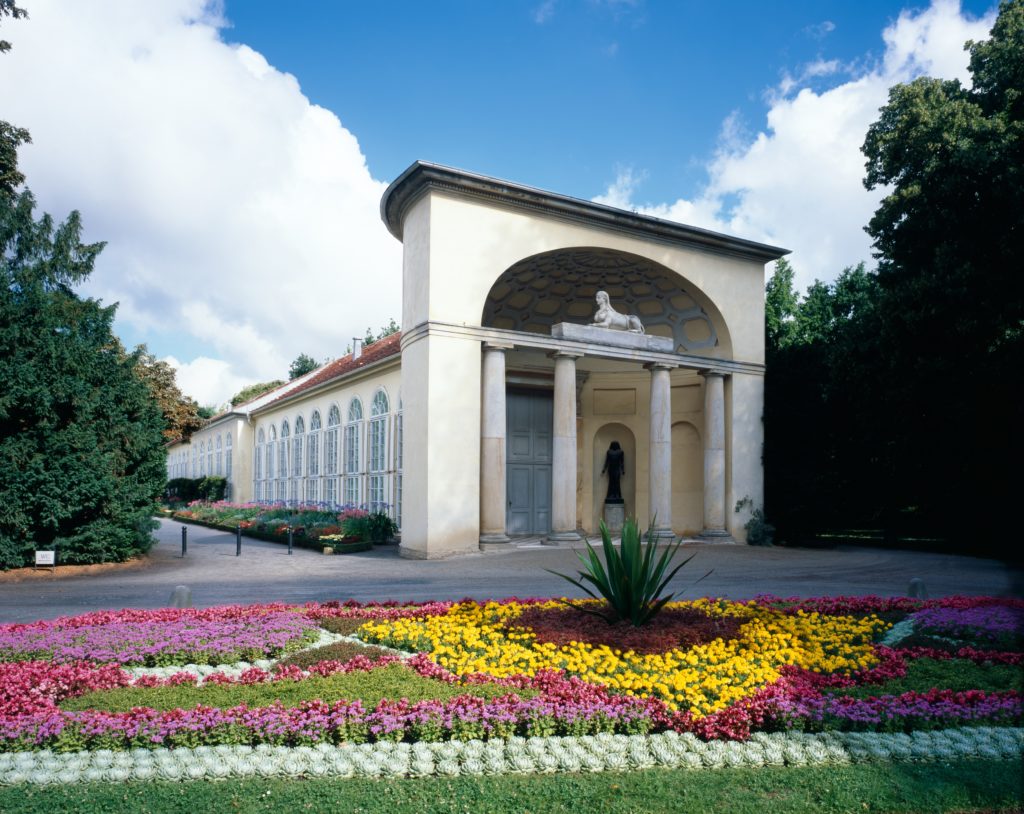


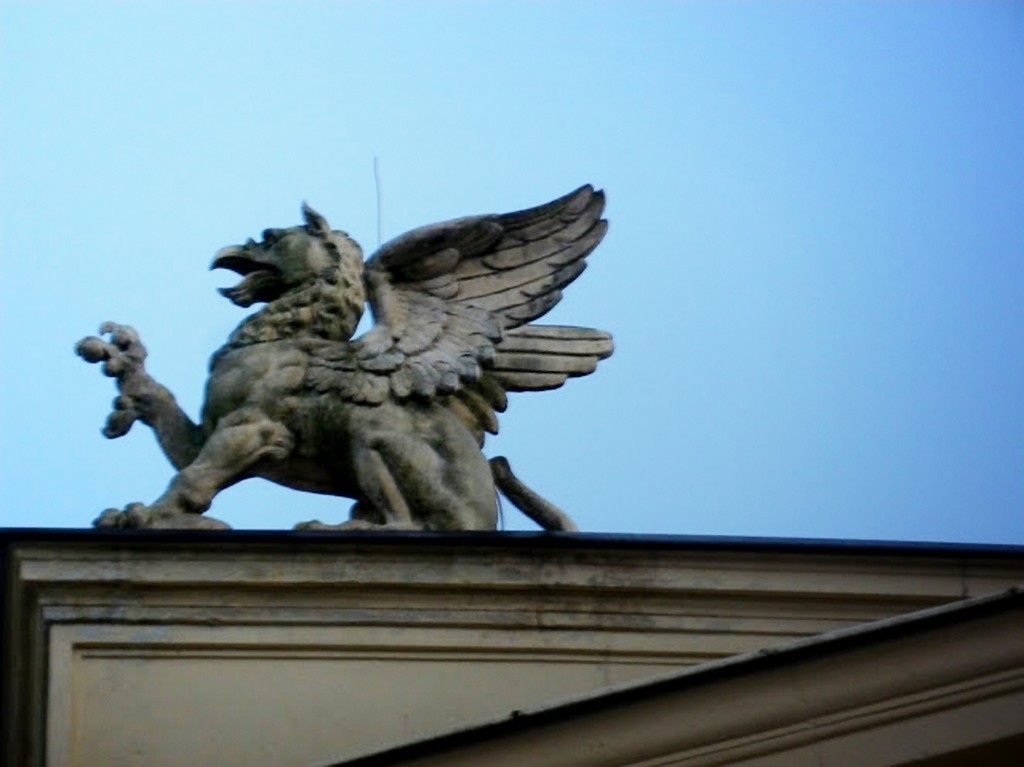

Der Venustempel im Wörlitzer ParkDer Venustempel im Wörlitzer Park Der Venustempel im Wörlitzer Park (Detail)Der Venustempel im Wörlitzer Park (Detail) Der Venustempel im Wörlitzer Park (Detail)Der Venustempel im Wörlitzer Park (Detail) Wörlitzer Wörlitzer Wörlitzer Iris, Theatrum – Hieroglyphicum, Munich, Frederick William Eugen Döll Wörlitzer Iris, Theatrum – Hieroglyphicum, Munich, Frederick William Eugen Döll
1/7
Ancient portal (Egyptian) at the Orangerie in the New Gardens in Potsdam, Johann Gottfried Schadow (traditional ascription), Egyptian guards (one original copy after antique Egyptianising Antinous in Rome, Vatican City), sandstone, combined black, ca 1791-93, Potsdam, new garden, porch of the Orangery (Foundation for Prussian Palaces and Gardens Foundation Berlin-Brandenburg)
Isis holding sistrum and oinochoe (Roman marble, reign of Hadrian) Capitolini Marble Life size with restorations
Fortuna-Isis restored as Faustina the Younger as Demeter. The head, hands and legs are modern restorations, 2nd century A.D.. Naples National Archaeology Museum, Farnese Collection
Bust of Isis-Sothis-Demeter. White marble, Roman artwork, the second part of Hadrian’s reign, ca. 131–138 CE. From the gymnasium in the Villa Adriana, near Tivoli, 1736, Museo Gregoriano Egiziano
Antikenportal (ägyptisch) an der Orangerie im Neuen Garten in Potsdam, Johann Gottfried Schadow (traditionelle Zuschreibung), Ägyptischer Wächter (Kopie nach antikem Original eines ägyptisierenden Antinous in Rom, Vatikan), Sandstein, schwarz gefaßt, ca. 1791–93, Potsdam, Neuer Garten, Portal der Orangerie
(Stiftung Preußische Schlösser und Gärten Berlin-Brandenburg)
Ancient portal (Egyptian) at the Orangerie in the New Gardens in Potsdam, Johann Gottfried Schadow (traditional ascription), Egyptian guards (one original copy after antique Egyptianising Antinous in Rome, Vatican City), sandstone, combined black, ca 1791-93, Potsdam, new garden, porch of the Orangery
(Foundation for Prussian Palaces and Gardens Foundation Berlin-Brandenburg)
Wörlitzer “Osiris”-Relief (KAt. 127) hat der Gothaer Hofbildhauer Friedrich Wilhelm Eugen Doell (1750 – 1816) diese Büste dann mit dem Körper der Münchener Statue eines falkenköpfigen Gottes (Kat. 104) kombiniert.
Wörlitzer “Osiris”- Friedrich Wilhelm Eugen Doell
Pantheon, Iris, Osiris, Horus, Anubis
Marble Palace, Isis
Orangery, Sphinx
Museum of Egyptian Art in Munich
http://aegyptisches-museum.de/index.php?id=170
Theatrum Hieroglyphicum Theatrum Hieroglyphicum
Ägyptisierende Bildwerke im Geiste des Barock Ägyptisierende image works in the spirit of the Baroque
11th März 2011 bis 22. March 2011 to 22 Januar 2012 January 2012
Knauf-Museum Knauf Museum
97343 Iphofen, Am Marktplatz 97343 Iphofen, Am Marktplatz
Das Interesse der Ägyptenrezeption des 18. The interest of Egypt reception of the 18th Jahrhunderts spiegelt sich nicht nur in der beginnenden Sammlungstätigkeit einzelner Fürsten wider, sondern führte auch zur Schaffung ägyptisierender Bildwerke. Century reflected not only in the beginning collection activity of individual rulers, but also led to the creation of Egyptian style statues. In der Ausstellung werden Architektur und Skulpturen des ägyptischen Teils aus dem Pantheon in Wörlitz (Sachsen) rekonstruiert und das Münchner Ensemble ägyptisierender Götterbilder vorgestellt, das im 18. In the exhibition, architecture and sculpture of the Egyptian part of the pantheon in Wörlitz (Saxony) reconstructed and presented to the Munich Company Egyptian style idols, in the 18th Jahrhundert in Italien entstanden und von Kurfürst Karl Theodor erworben worden war. Century had been originated in Italy and acquired by Elector Karl Theodor.
Theatrum Hieroglyphicum: Die Hauptdarsteller dieses barocken Hieroglyphischen Theaters sind Osiris, Isis und Horus – die klassischen Gottheiten Altägyptens. Theatrum Hieroglyphicum: The protagonist of this hieroglyphic baroque theater are Osiris, Isis and Horus – the classic gods of ancient Egypt. Im Hieroglyphischen Theater treten sie auf als dunkle, geheimnisvolle Gestalten, und ihre Farbe ist demzufolge meist auch schwarz, zur deutlichen Unterscheidung von den hellen, strahlend weißen Göttergestalten Griechenlands und Roms, also des Pantheons der klassischen Kulturen Europas. In hieroglyphic theater do they appear as dark, mysterious figures, and their color is therefore usually black, to clearly distinguish them from the bright, crisp white gods of Greece and Rome, so the pantheon of classical cultures of Europe. Der farbliche Kontrast symbolisiert den typischen Gegensatz zwischen Lichtsphäre und Unterwelt, zwischen Bewußtem und Unbewußtem, zwischen Leben und Tod. The color contrast symbolizes the typical contrast between light sphere and the underworld, between conscious and unconscious, between life and death. Diese in der mythologischen Tradition des Humanismus und der Kunst der Renaissance stehende Wiedergeburt der antiken Götterwelt ist charakteristisch für die Ägyptenrezeption der Barockzeit. Current standing in the mythological tradition of humanism and the Renaissance art revival of the ancient gods of Egypt is characteristic of the reception of the Baroque period.
Die im Geiste des Barock geschaffenen ägyptisierenden Bildwerke aus dem Pantheon in Wörlitz und aus dem Königlichen Antiquarium der Münchener Residenz stellen die beiden einzigen bekannten Götterensembles dieser Art aus der Zeit des Klassizismus dar. Es handelt sich dabei um nicht nur nachweisbar und deutlich sichtbar an antiquarischen Vorlagen orientierte, sondern davon auch inspirierte Neuschöpfungen im ägyptischen Stil aus der 2. In the spirit of the baroque created Egyptianising sculptures from the Pantheon, Worlitz and from the Royal Antiquarium in the Munich Residenz, the two only known gods ensembles of its kind in the Classicist period represents This is to not only demonstrably and clearly visible on antique originals oriented, but it also inspired creations in the Egyptian style from the 2nd Hälfte des 18. Half of the 18th Jahrhunderts, die, hergestellt in fürstlichem Auftrag, im Medium der Kunst die als Mysterium empfundene altägyptische Kultur repräsentieren sollten. Century, which should made in princely order, the medium of art, perceived as representing mystery ancient Egyptian culture.
Photo: 2011″‘ type=”#_x0000_t75″ alt=”http://www.aegyptisches-museum-muenchen.de/assets/components/phpthumbof/cache/bba15da458f32dfb90ad0f98e86cf64c.56aaaf2b40dc2d9f2b05e0d2aa3de54c.jpg” href=”http://www.aegyptisches-museum-muenchen.de/assets/components/phpthumbof/cache/bba15da458f32dfb90ad0f98e86cf64c.0a06639280bc493d8b3f39ee5af11488.jpg” o:button=”t” o:spid=”_x0000_i1027″>http://www.aegyptisches-museum-muenchen.de/assets/components/phpthumbof/cache/bba15da458f32dfb90ad0f98e86cf64c.56aaaf2b40dc2d9f2b05e0d2aa3de54c.jpg” href=”http://www.aegyptisches-museum-muenchen.de/assets/components/phpthumbof/cache/bba15da458f32dfb90ad0f98e86cf64c.0a06639280bc493d8b3f39ee5af11488.jpg” o:button=”t” o:spid=”_x0000_i1027″>
Photo: 2011″‘ type=”#_x0000_t75″ alt=”http://www.aegyptisches-museum-muenchen.de/assets/components/phpthumbof/cache/06f30bfe864b36cd80bf1e51aa464eeb.56aaaf2b40dc2d9f2b05e0d2aa3de54c.jpg” href=”http://www.aegyptisches-museum-muenchen.de/assets/components/phpthumbof/cache/06f30bfe864b36cd80bf1e51aa464eeb.0a06639280bc493d8b3f39ee5af11488.jpg” o:button=”t” o:spid=”_x0000_i1026″>
Photo: 2011″‘ type=”#_x0000_t75″ alt=”http://www.aegyptisches-museum-muenchen.de/assets/components/phpthumbof/cache/071aaa6a7b23377e8ba5bbf72f143571.56aaaf2b40dc2d9f2b05e0d2aa3de54c.jpg” href=”http://www.aegyptisches-museum-muenchen.de/assets/components/phpthumbof/cache/071aaa6a7b23377e8ba5bbf72f143571.0a06639280bc493d8b3f39ee5af11488.jpg” o:button=”t” o:spid=”_x0000_i1025″>
Der geistesgeschichtliche Hintergrund dieses in barocker Manier inszenierten Theatrum Hieroglyphicum ist somit die für das späte 18. The historical background of this staged in baroque style Theatrum Hieroglyphicum is thus the 18th for the late Jahrhundert symptomatische fürstliche Sammeltätigkeit – und die Enträtselung dieser ägyptisierenden Bildwerke gibt deshalb nicht nur Einblick in die kunsthistorische Dimension, sondern vor allem auch in den ideengeschichtlichen Prozess der in Europa bereits im Mittelalter einsetzenden Ägyptenmode. Symptomatic century princely collecting – and the unraveling of this Egyptianising sculptures are therefore not only an insight into the art-historical dimension, but also in the intellectual history of the process in Europe in the Middle Ages onset Egypt fashion.
Dabei stehen die hieroglyphenkundlichen Münchener Götterfiguren stellvertretend für die allgemeine Ägyptophilie bzw. Ägyptosophie im Geiste des Barock, die ägyptisierenden Wörlitzer Bildwerke dagegen für die Ägyptomanie bzw. Ägyptenromantik der Goethezeit. Here, the hieroglyphics known union Munich idols are representative of the general Ägyptophilie Ägyptosophie or in the spirit of the Baroque, the Egyptianising Wörlitzer sculptures contrast to Egypt and Egyptomania Romantic Age of Goethe.
National Museum of Egyptian Art in Munich, Arcisstraße 16, 80333 Munich
___________________________________________________________________
Chodowiecki, Daniel Nikolaus 1776 – Goethe
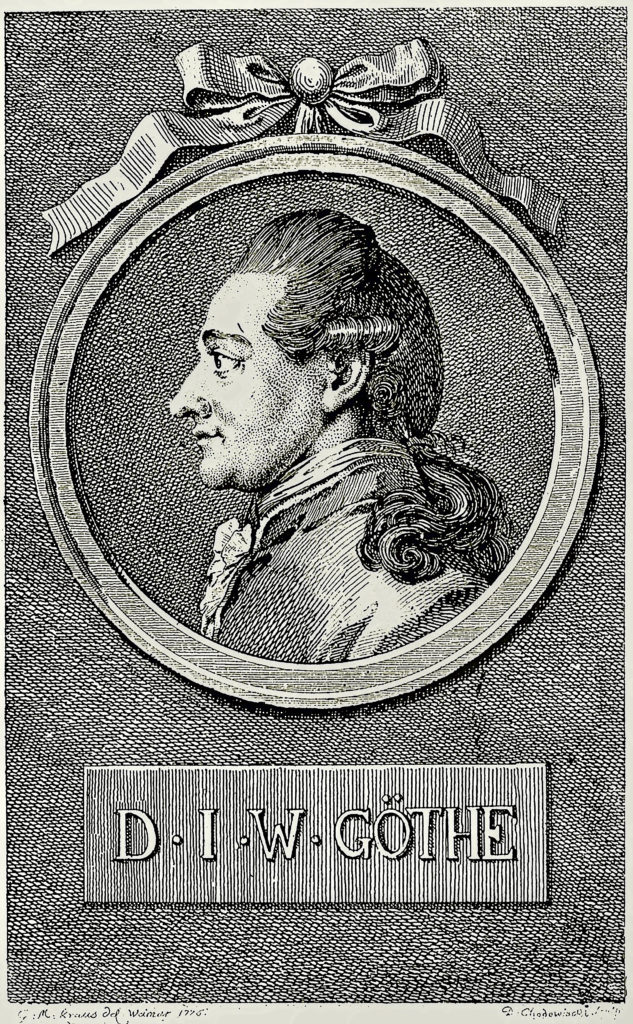
Chodowiecki Daniel Nikolaus – Entstehungsjahr 1787, Pyramid Eye
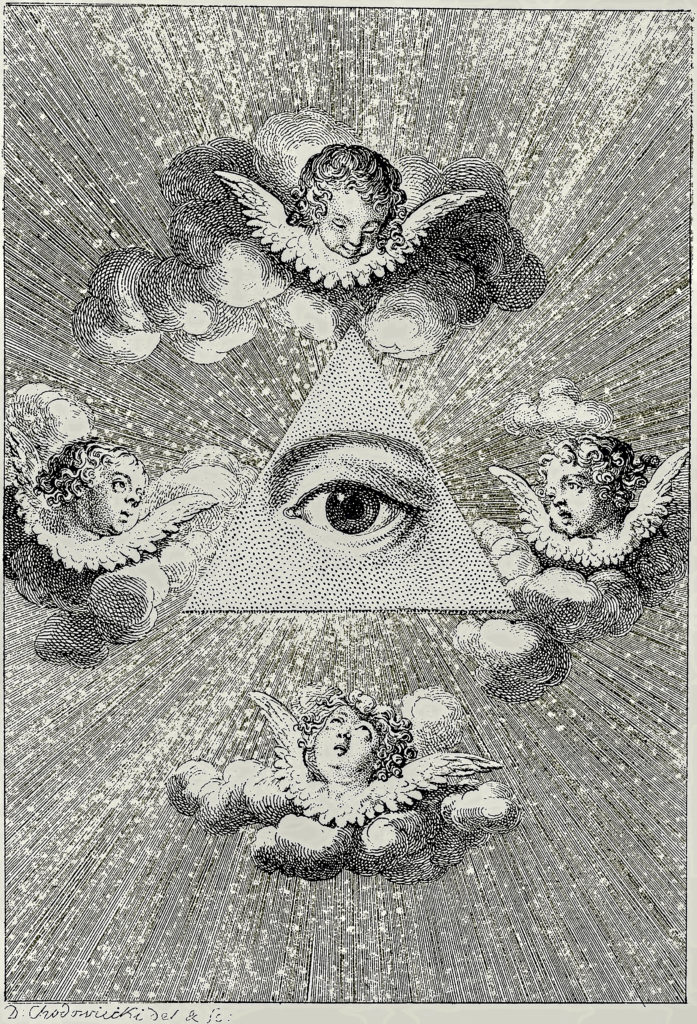
_____________________________________________________________________
Kegeldach, Büste, Marmorrelief (Kopien, Originale im Hist. Museum) und astronomischen Symbolen, 1806/1808 von Emanuel dHerigoyen, Büste von Friedrich Döll, Marmorrelief von Johann Heinrich von Dannecker; bis 1859 weiter westlich. Prince Anselm Avenue; Monument to Johannes Kepler, Doric monopteros with Kegeldach, bust, marble relief (copies, originals in the hist. Museum) and astronomical symbols, 1806/1808 by Emanuel dHerigoyen, bust by Friedrich Döll, marble relief by Johann Heinrich von Dannecker; Until 1859 further west.

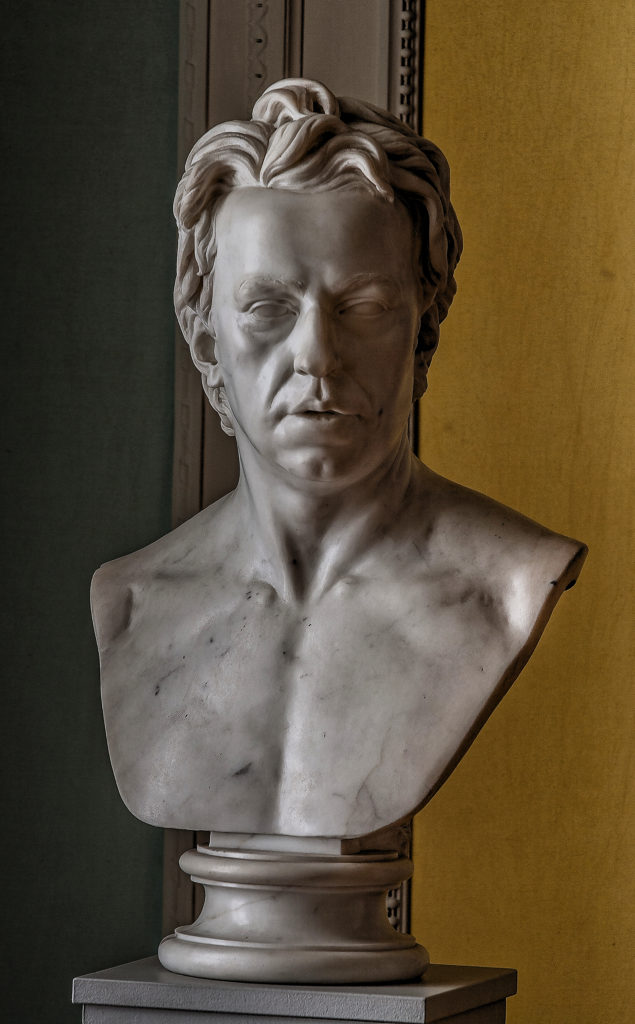
Büste des Johannes Kepler von Friedrich Döll im 1806/08 von Emanuel d’Herigoyen errichteten Denkmal an der Fürst-Anselm Allee in Regensburg, nahe der Grabstätte im alten Petersfriedhof.
English: Bust of Johannes Kepler by Friedrich Döll. It is placed within the Kepler memorial that was erected by Emanuel d’Herigoyen at the Fürst-Anselm Allee in Regensburg, near Kepler’s burial.
Sculpture Works of Friedrich Wilhelm Eugen Döll
In Wörlitz are gardens, and buildings that are a UNESCO World Heritage-listed site. The “Dessau-Wörlitz Garden Empire,” were built in the second half of the 18th Century under the reign of Prince Leopold III. Friedrich Franz of Anhalt-Dessau (1740-1817). The park is part of the network Gartenträume Saxony-Anhalt. In the basement of the Pantheon is a cave “unterquerender” that holds a Kanope, which is a symbol of Elbflusses, reliefs of Anubis, of Osiris and the Harpokrates and a statue of Isis. They were developed by Friedrich Wilhelm Eugen Doell (1750-1816) created and belong to the earliest after ancient Egyptian art templates created in Germany.
Sculpture works of Eugen Doell:
Faith, Love and Hopeat the Hauptkirche in Luneburg.
22 stucco high-reliefs at the princely riding-school at Hauptreliefs in Stuck an der fürstlichen Reitbahn in Dessau
a lifesize statue of Catherine II of Russia as Minerva
Catherine II, with a maiden before her offering at an altar
Winckelmann’s monument in the Rotonda in Rome
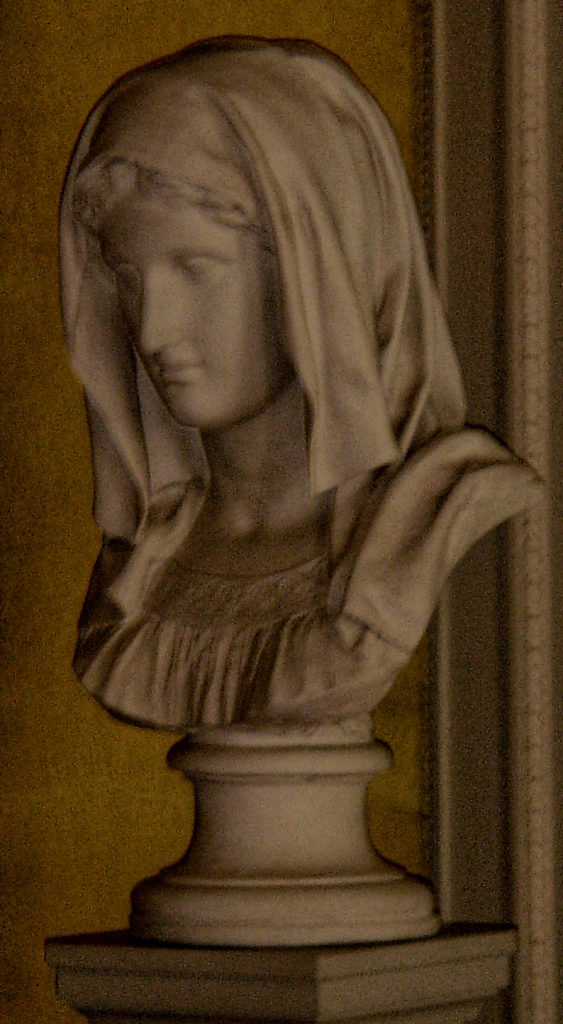
Eugen Doell – Female Bust Hooded, Gotha
busts of Sappho and Raphael Mengs
The New Muses, Bas-relief, Gustavus Adolphus of Sweden on a horse, crowned by victories, bas-relief , Gustav Adolfs torg (Swedish for “Gustav Adolf’s Square”) is a public square in central Stockholm, Sweden named after King Gustavus Adolphus.
The square is home to the Royal Opera, the Swedish State Department, Arvfurstens palats (housing the Ministry for Foreign Affairs) and the Ministry of Defence. South of the square are the Parliament on Helgeandsholmen and the Royal Palace in Stockholm Old Town. In the middle of the square there is a statue of Gustav II Adolf, which was erected in 1796.
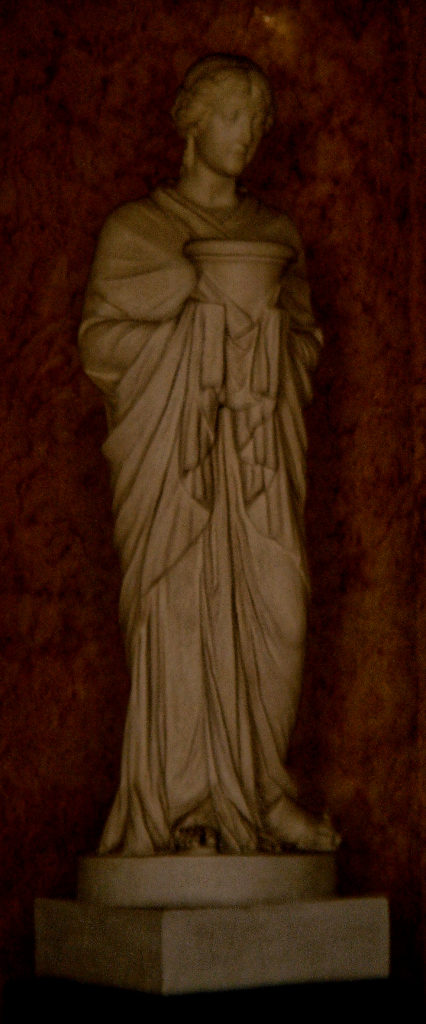
Eugen Doell – Female Robed With Vase, Gotha
lifesize figures of Minerva, a Muse, and Hygieia;
grave-monument to the Gräfin von Einsiedel at Dresden and duke Karl von Meiningen;
monument to Gotthold Ephraim Lessing at the Wolfenbüttel library
Kepler’s statue at Regensburg.



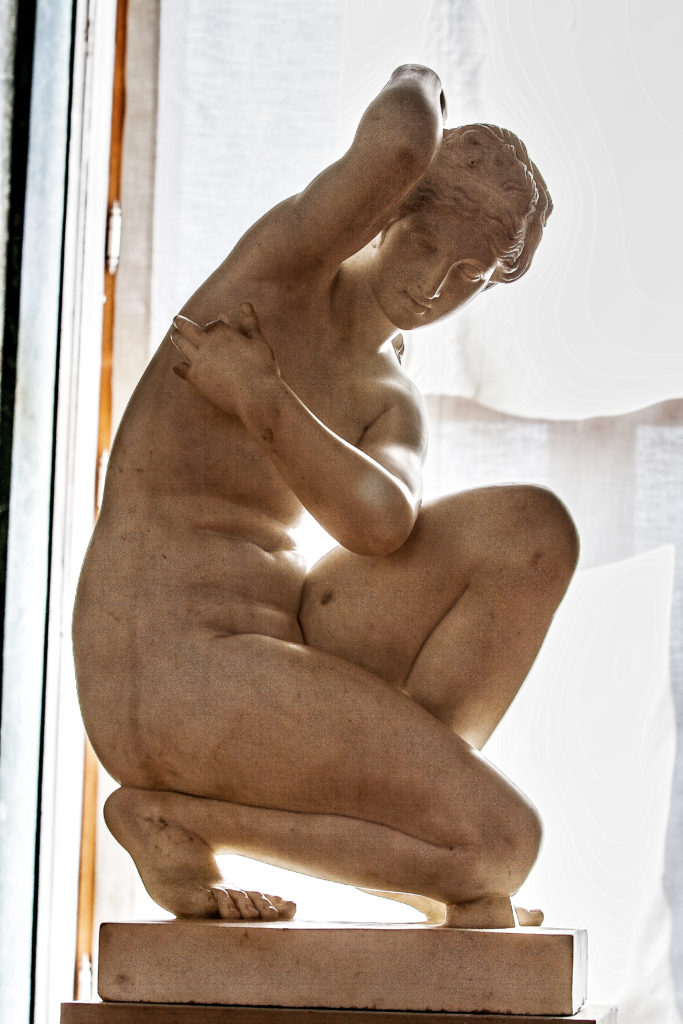
Crouching Venus, Aphrodite – Leopold Döll – Schloss Friedenstein, Gotha, Thüringen
Leopold Doel, – “Crouching Athena Figure”
APHRODITE “CROUCHING APHRODITE”, Musée du Louvre, Paris, France, “Aphrodite accroupie”, Material: Marble, Height: 0.71 metres, Copy by Greek sculptors of an earlier Greek statue C3rd BC, during Roman Imperial period, Style: Hellenistic, Aphrodite crouching, bathing herself with upraised arm. The goddess is raising her left hand towards her neck whereas the prototype used to cross her arms on her breast., H. 71 cm, Collections of Louis XIV of France; seized during the French Revolution (27 ¾ in.), Department of Greek, Etruscan and Roman Antiquities, Sully, ground floor, room 17, Louvre Museum, Paris France
The sculptor Friedrich Wilhelm Eugen Döll’s son – the sculptor Friedrich Leopold Döll, (1791-1856)
On cemetery I also called “old gods”, these two sphincters stood on the hereditary tombs of the Rosenberg family. The sphinxes came from the hand of the sculptor Leopold Döll. In 1908, the sphinxes were dismantled and brought to Coburg, where they now guard around the rear exit of the castle to the park.
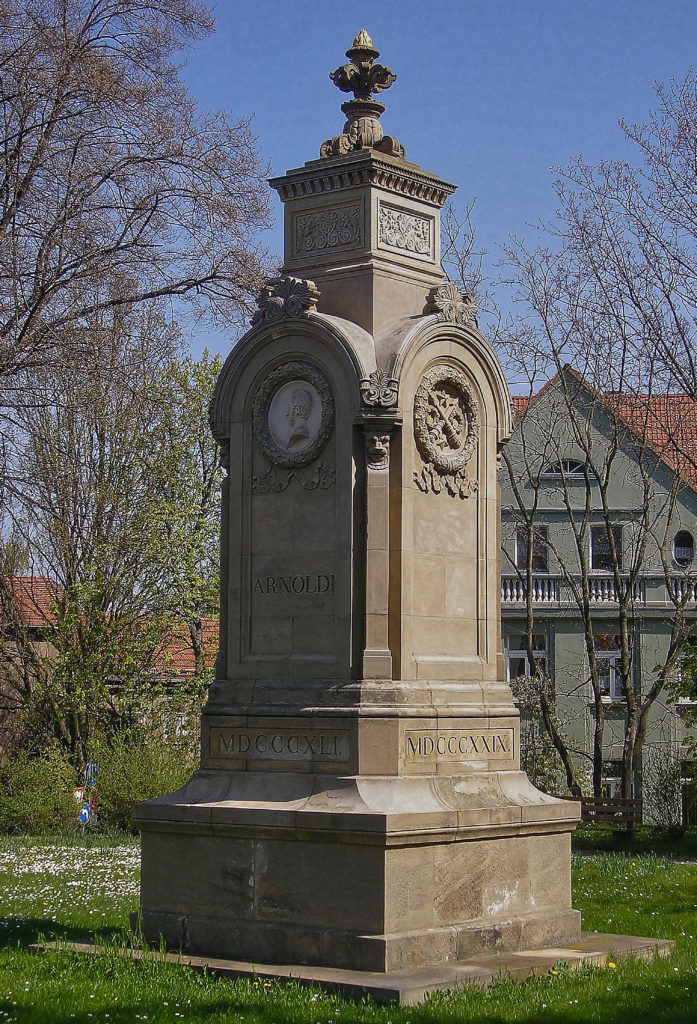
Arnoldidenkmal – Leopold Frederich Doell –
Gotha ,
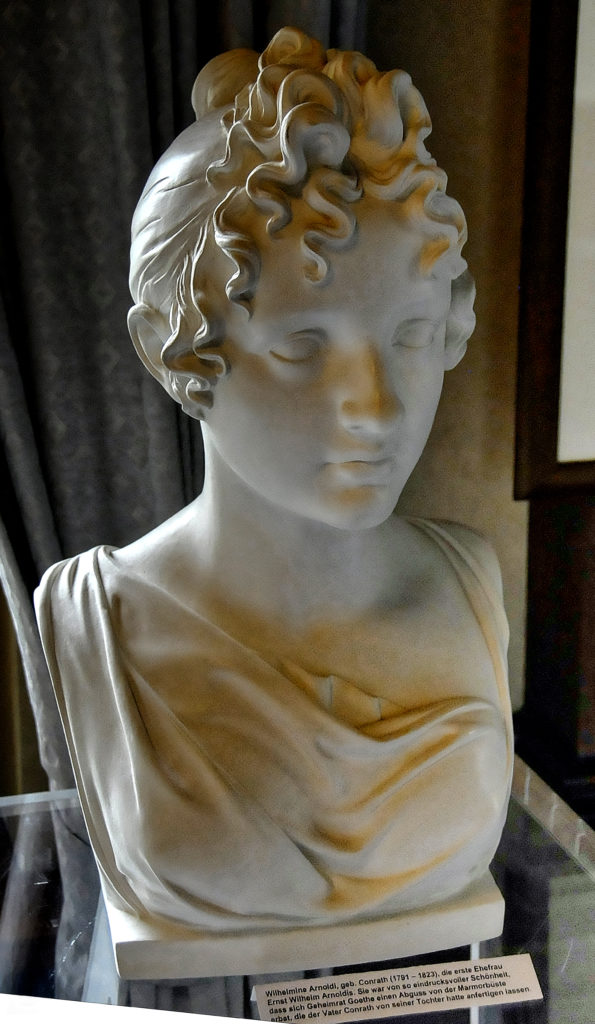
The influence of Crouching Aphrodite Greek Hellenistic and Greco-Roman sculpture on Leopold Fredrich Doell



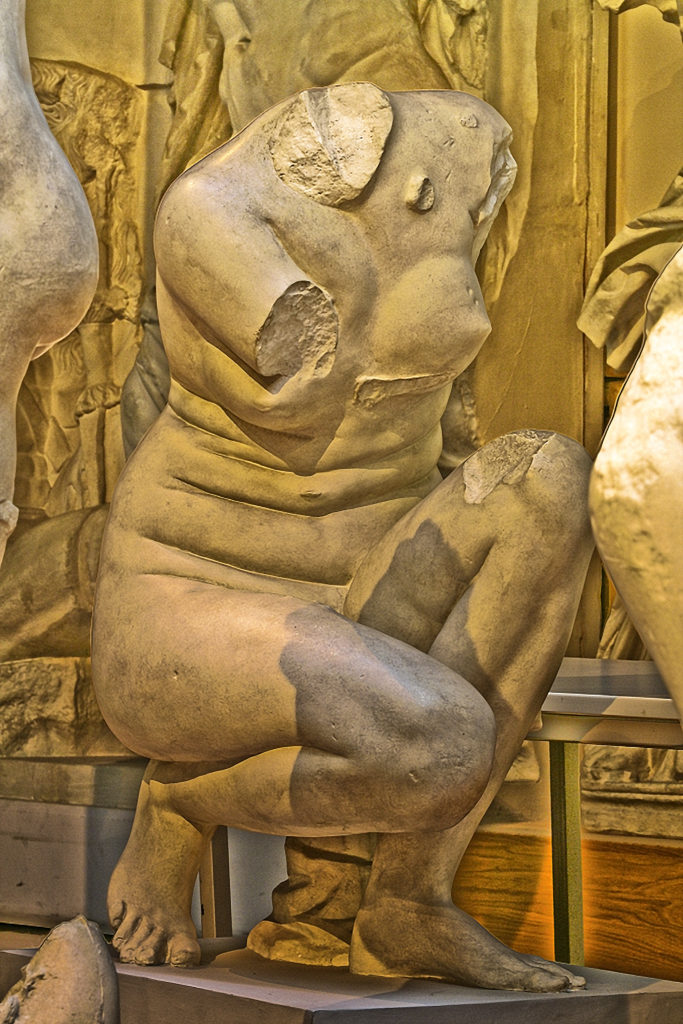
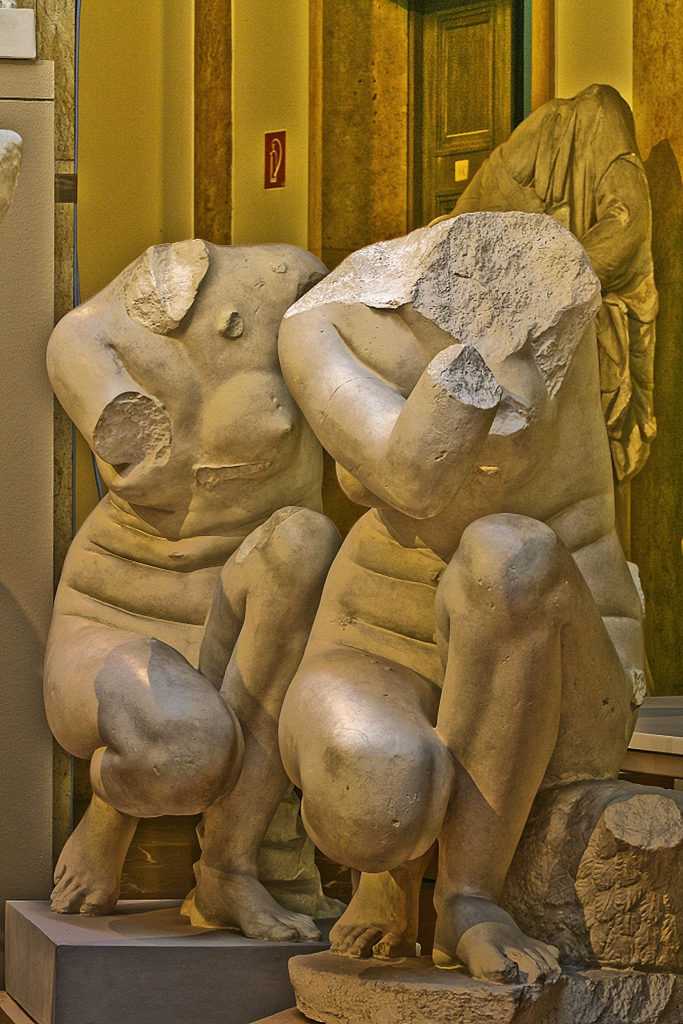
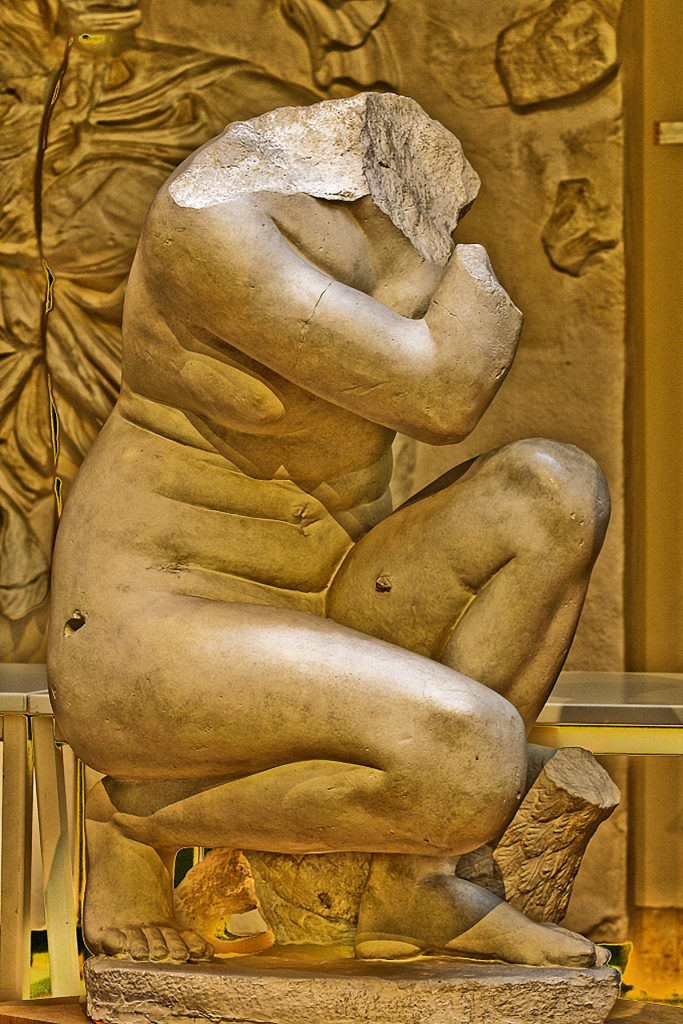

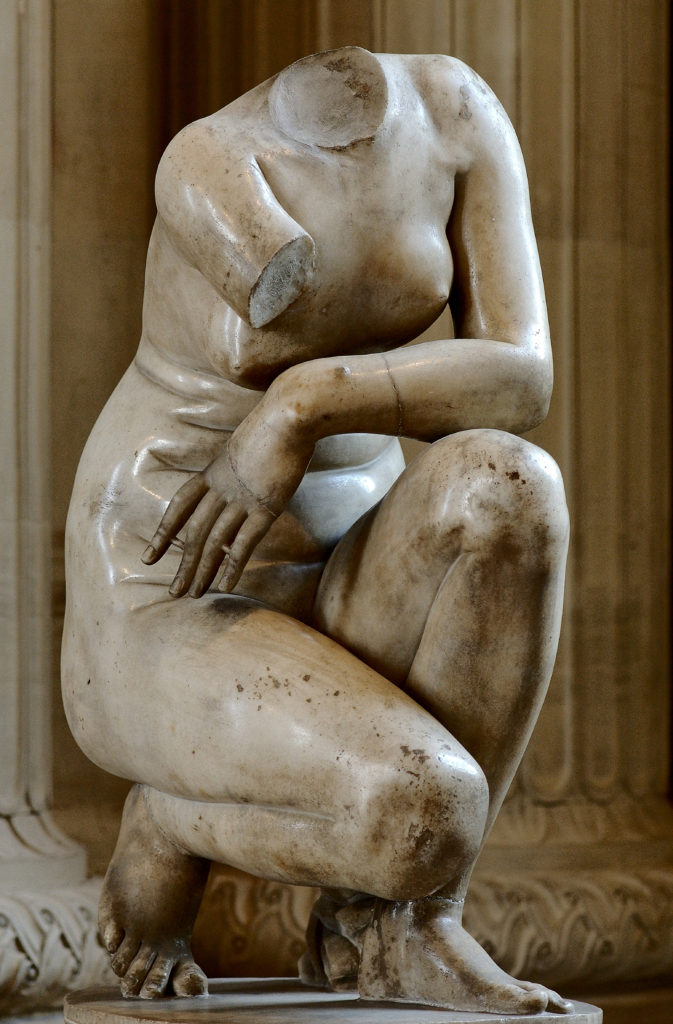
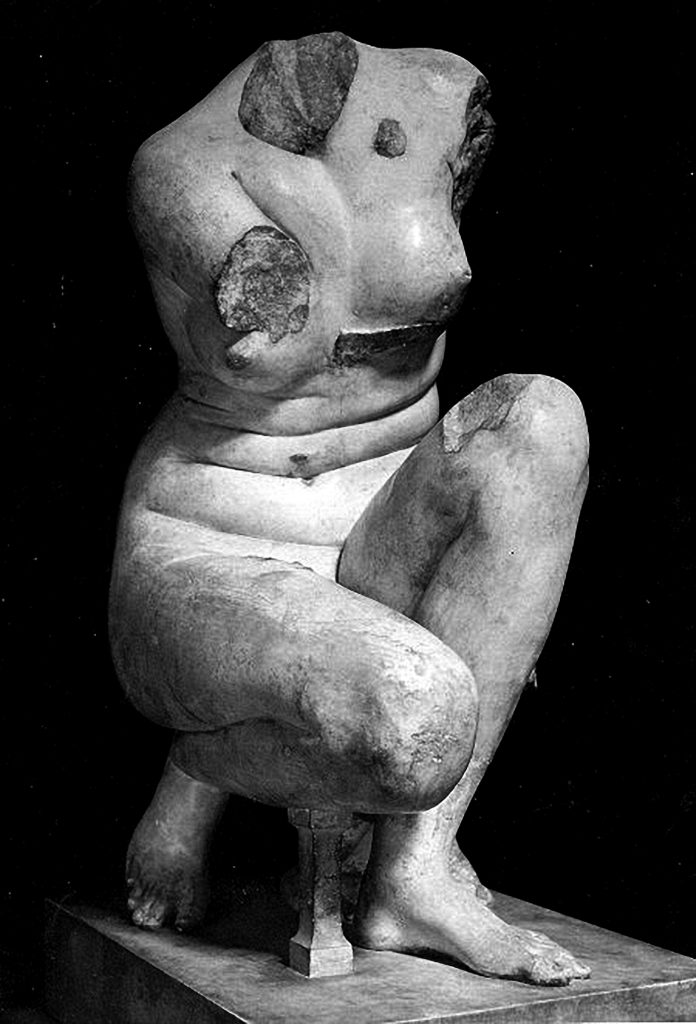
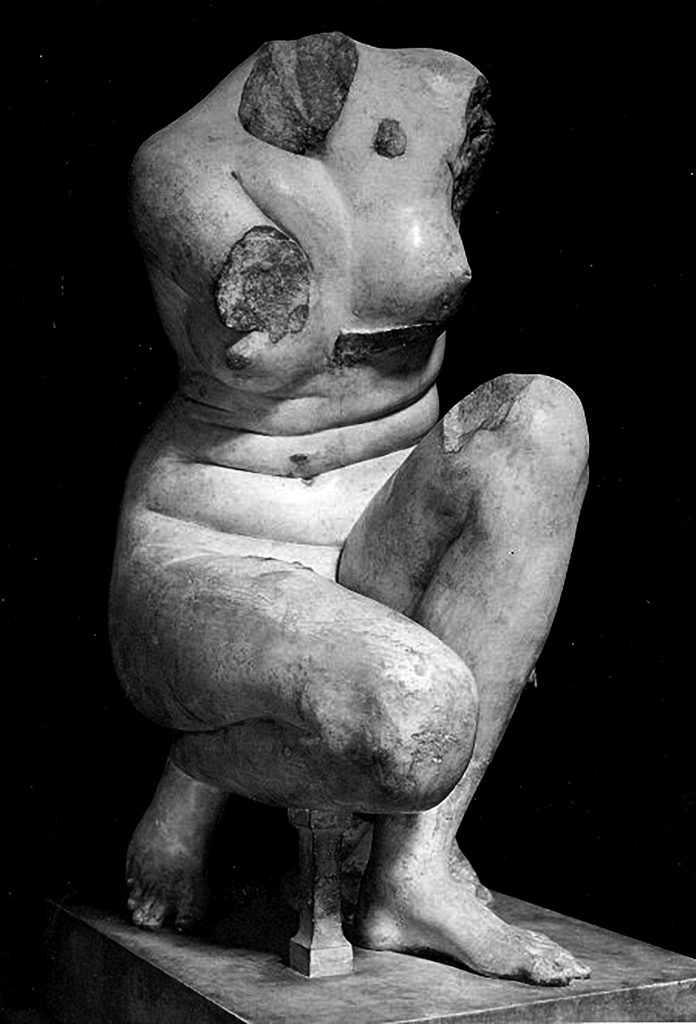
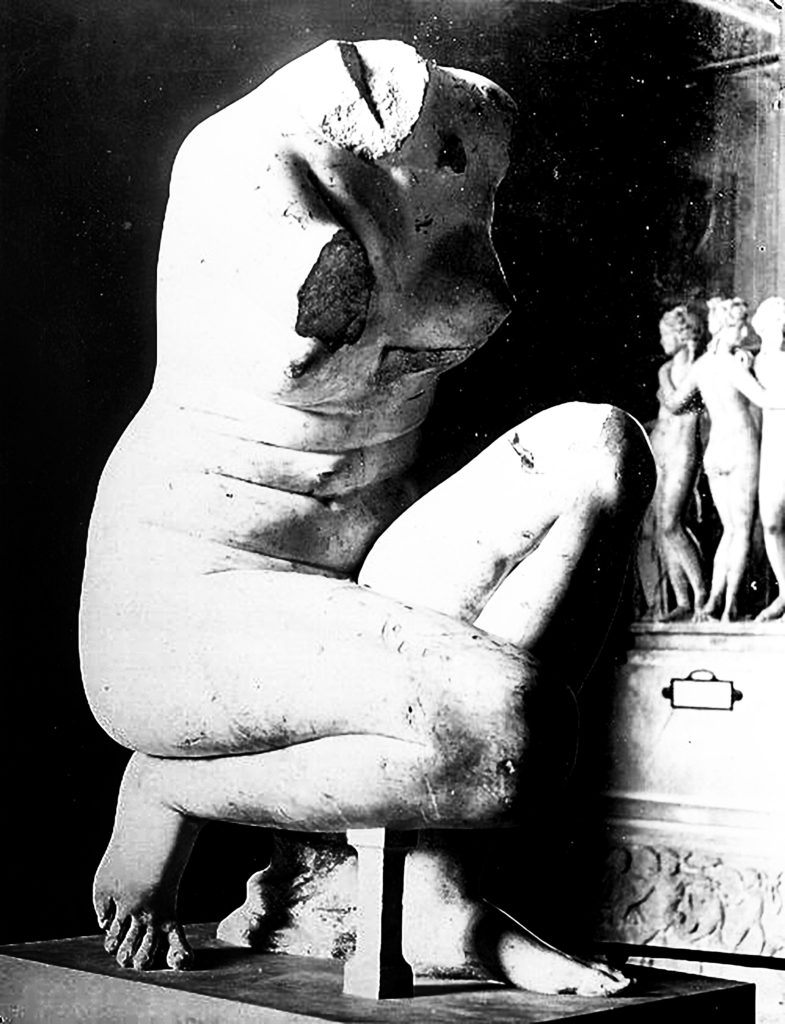
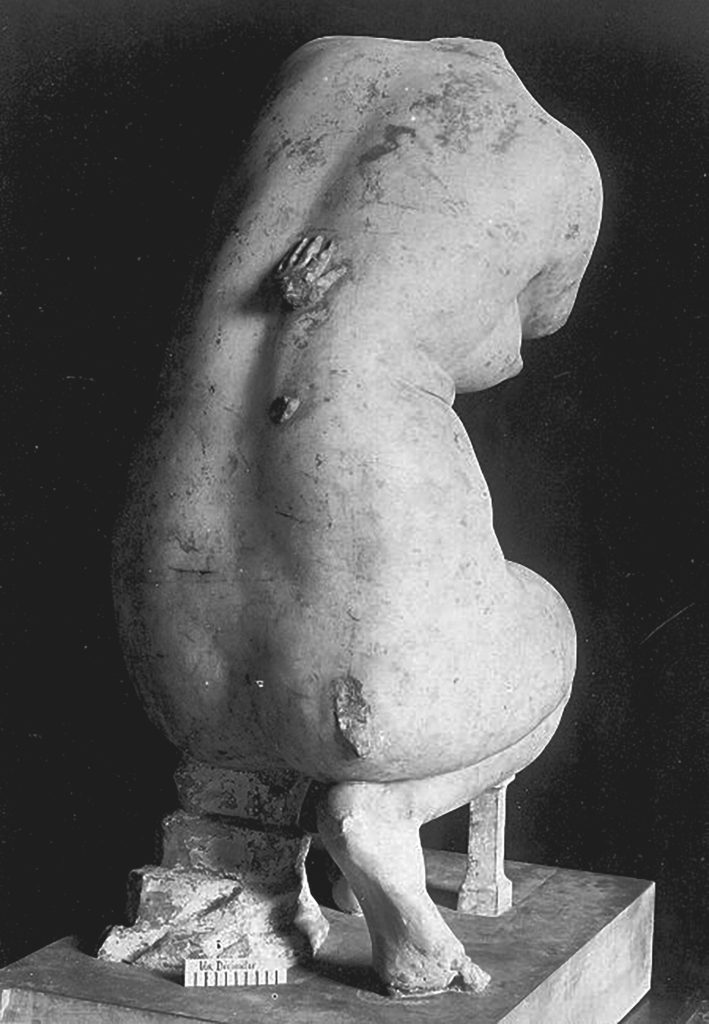

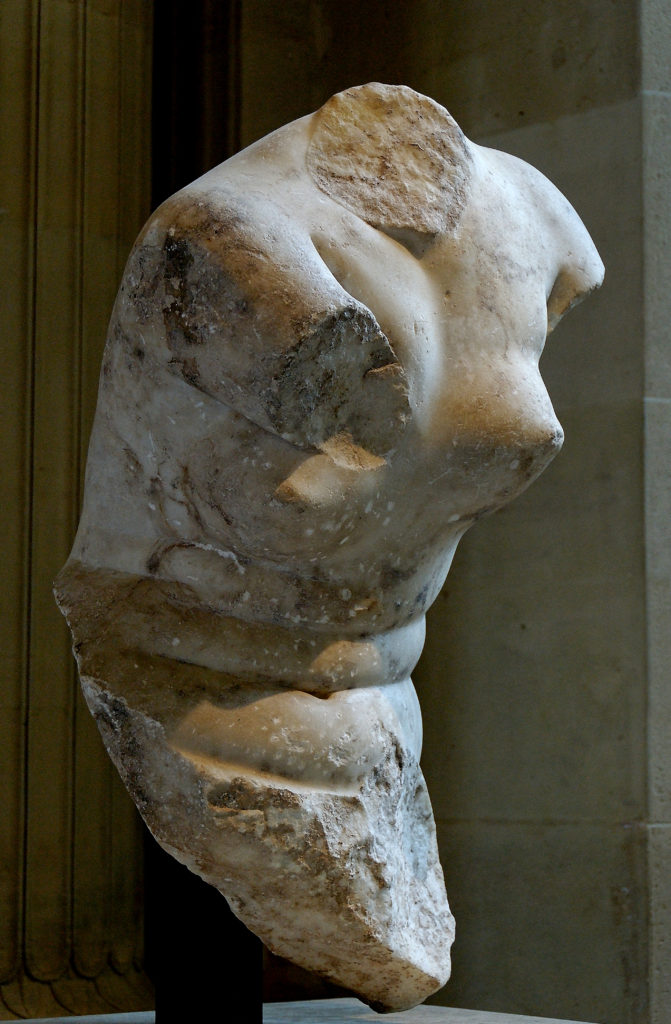
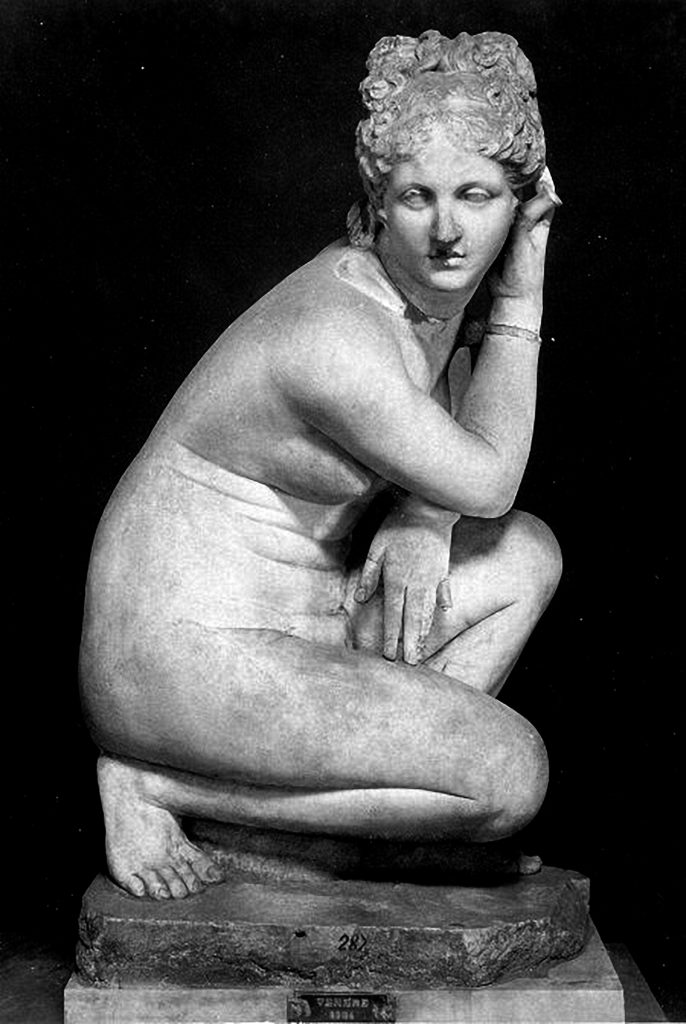
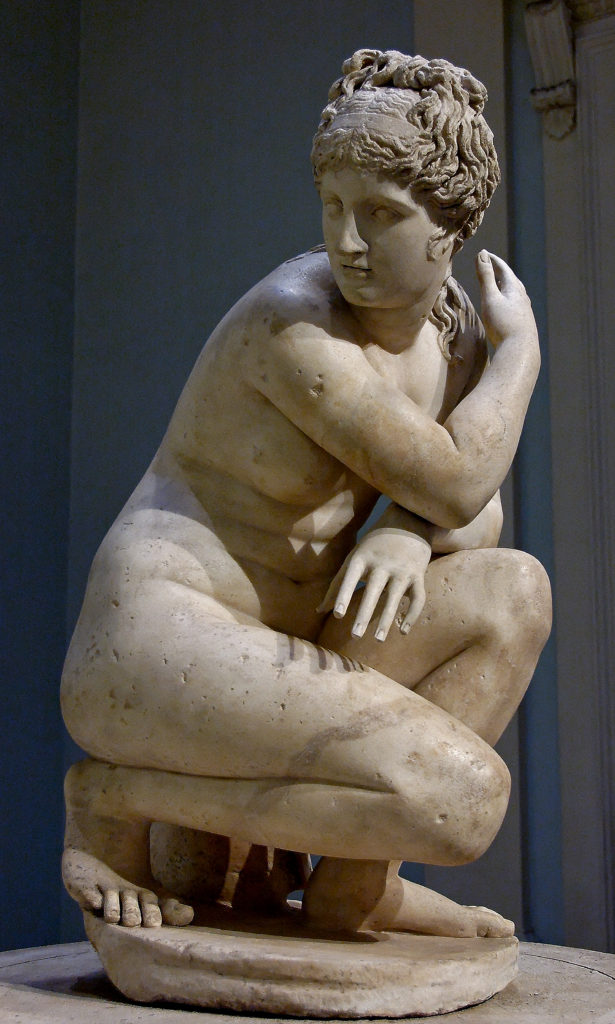
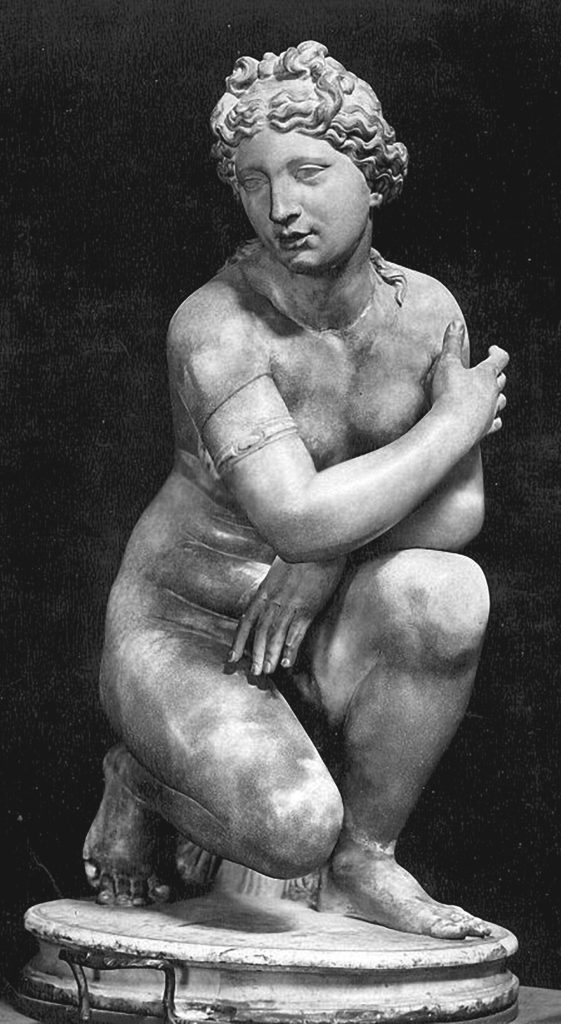
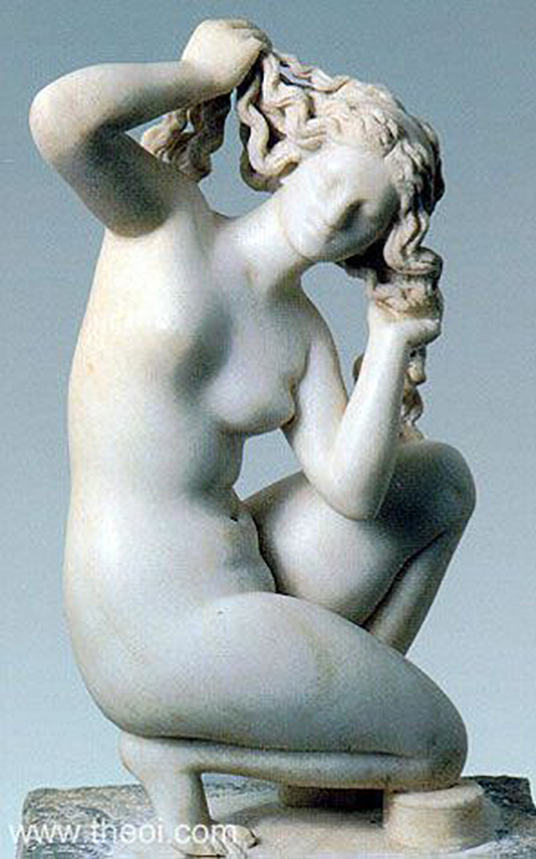



Leopold Friedrich Döll – Two Sphinx – Gotha, Now In Coburg
